Why an Air Conditioner for Your Patio is Essential in 2025
As climate change continues to reshape weather patterns across the globe, the demand for outdoor cooling systems is on the rise. In recent years, there has been a significant increase in the popularity of outdoor living spaces such as patios, decks, and backyards, and people are increasingly looking for ways to enhance the comfort of these spaces. Whether you’re hosting a family BBQ, enjoying a relaxing evening, or working from home, having a comfortable outdoor environment has become more important than ever.
Growing Demand for Outdoor Cooling Systems Due to Climate Change
2025 marks a time when record-breaking summer heat waves are becoming more frequent, which can make outdoor spaces unbearable during the hottest months. The impact of climate change is evident in the unpredictable weather patterns and hotter temperatures, making traditional indoor air conditioning less effective in cooling outdoor living areas. As people spend more time outside, especially during the summer, there’s a clear need for innovative solutions to combat rising temperatures outdoors.
This shift in climate is directly contributing to the growing popularity of outdoor cooling systems like air conditioners for patios. The need for these systems is expected to keep increasing, particularly as more people seek refuge from heat waves by extending their living spaces outdoors. Whether it’s a residential patio, restaurant terrace, or outdoor event space, people are investing in efficient cooling solutions to make the most of their outdoor areas.
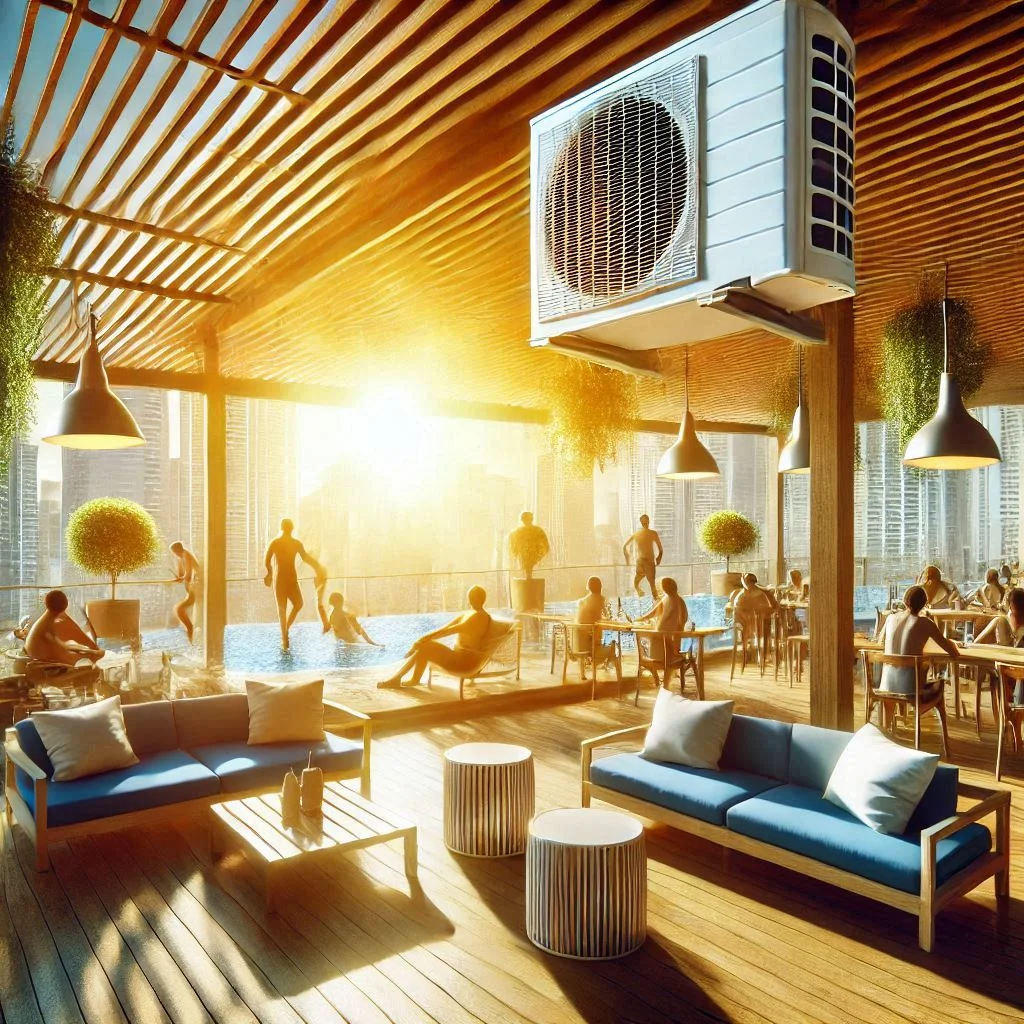
The Rise of Outdoor Living Spaces
The surge in the popularity of outdoor living spaces has been evident in recent years. Patios, gardens, and terraces are now viewed as an extension of the indoor living area, designed for comfort and enjoyment. Many homeowners are creating luxurious, multi-functional outdoor spaces where they can relax, dine, or entertain guests. These spaces are often equipped with cozy seating, outdoor kitchens, fire pits, and even entertainment systems. As people shift their lifestyles to include more time outside, the comfort of these spaces becomes a priority.
The outdoor living trend is also fueled by the increasing availability of stylish and durable furniture, décor, and technology that can withstand outdoor conditions. However, one critical factor that homeowners often overlook is the comfort of the temperature. As outdoor areas become more sophisticated, so do the expectations for maintaining a comfortable atmosphere. This is where air conditioning for patios comes in. By investing in an outdoor air conditioner, you can create a pleasant, cool environment, allowing you to enjoy your patio year-round—no matter how hot or humid it gets.
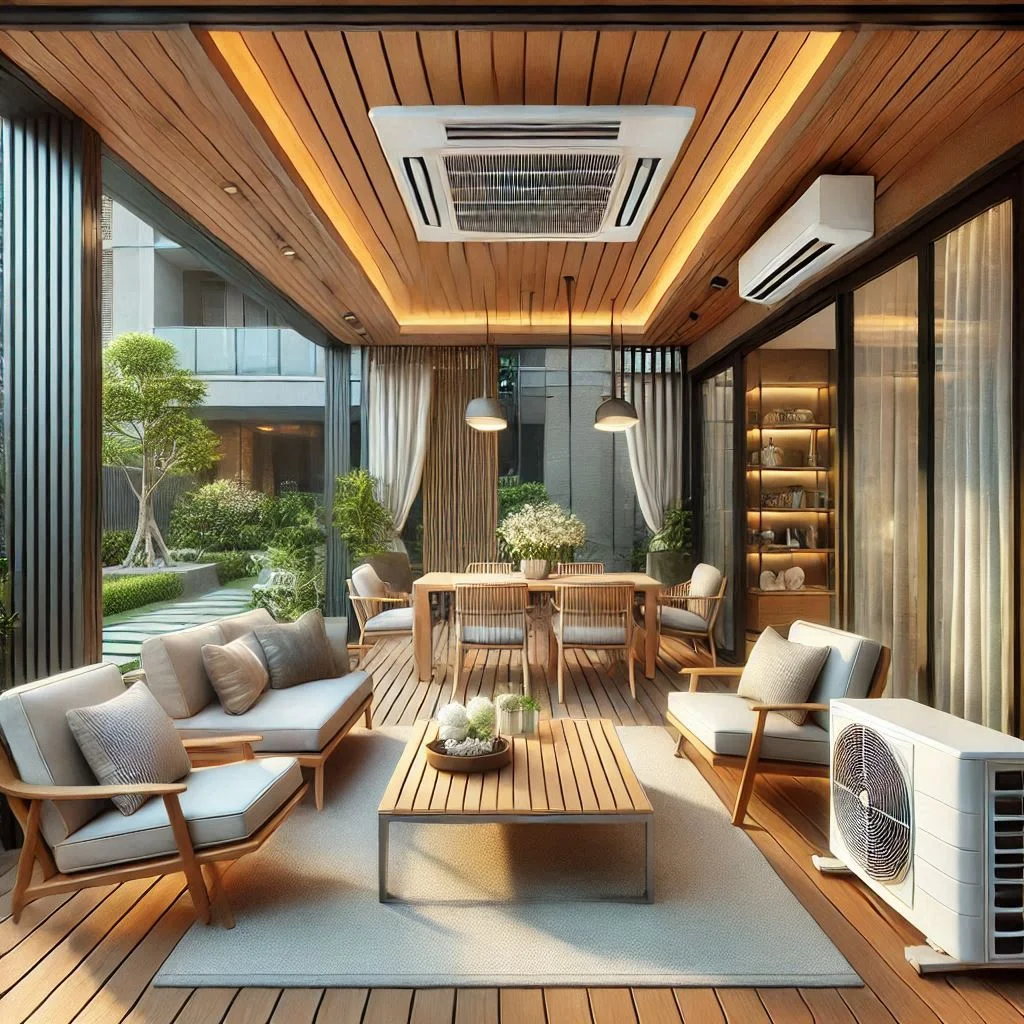
Comfort and Convenience of Outdoor Air Conditioning for Patios
Outdoor air conditioners provide numerous benefits that enhance both comfort and convenience. These systems are designed to handle the unique challenges of outdoor environments, such as exposure to humidity, direct sunlight, and dust. Traditional indoor air conditioners simply cannot keep up with the demands of an outdoor setting, making a dedicated outdoor air conditioner the best solution.
- Enhanced Comfort for Outdoor Gatherings: Whether you’re hosting a summer party, a family reunion, or a casual get-together, an outdoor air conditioner ensures that everyone stays comfortable, even during the hottest parts of the day. With the right cooling system in place, your guests will be able to enjoy your outdoor space without sweating under the sun or retreating indoors to escape the heat.
- Extended Outdoor Living: Outdoor air conditioning opens up new possibilities for year-round outdoor living. Hot summer days are no longer a barrier to enjoying your patio, and you can continue to use your outdoor space even in the peak of summer. With a reliable outdoor cooling solution, your patio becomes a comfortable sanctuary, allowing you to spend more time in your garden or on your terrace, day or night.
- Increased Home Value: Installing an air conditioner for your patio is an investment that can boost the value of your home. As outdoor spaces become an integral part of modern living, having a cooled patio can make your property stand out in the market. A well-maintained, air-conditioned patio offers potential buyers an additional selling point, especially in regions that experience high temperatures for extended periods.
- Energy-Efficient Cooling: Many modern outdoor air conditioners are designed with energy efficiency in mind. As environmental concerns and rising energy costs continue to grow, opting for an energy-efficient outdoor air conditioner can help reduce both your energy bills and your carbon footprint. With the right system, you can enjoy cool, comfortable outdoor living without the guilt of high electricity consumption.
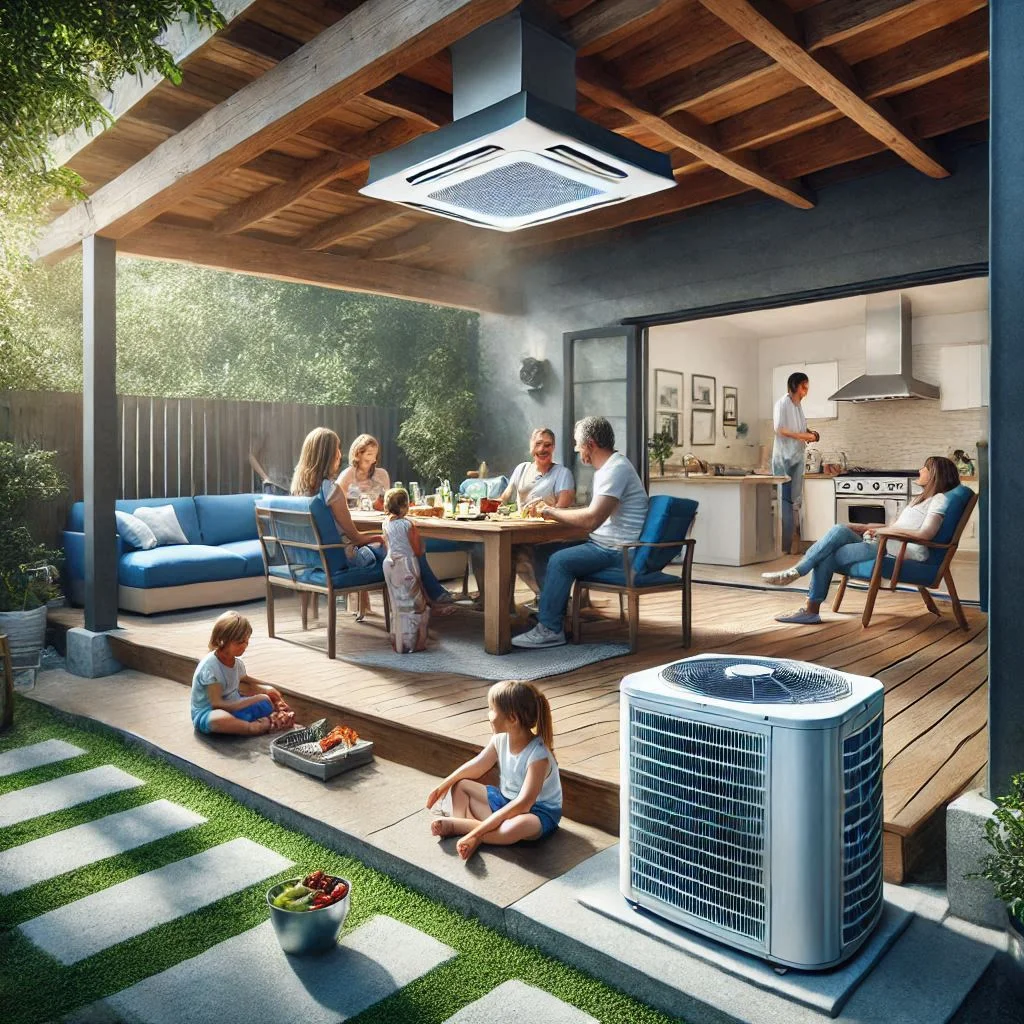
Types of Outdoor Cooling Systems for Patios
When it comes to cooling your outdoor patio, there are several options available that can cater to various needs and preferences. From energy-efficient evaporative coolers to high-powered air conditioners, each system has its own unique set of features and benefits. In this section, we’ll explore the most popular outdoor cooling solutions, including evaporative coolers, traditional air conditioners, portable air conditioners, and fans.
By understanding the different types of outdoor cooling systems, you can choose the best one to meet the needs of your patio space and create the perfect environment for outdoor relaxation.
Evaporative Coolers
What is an Evaporative Cooler?
Evaporative coolers, also known as swamp coolers, work by using water to cool the air. These systems pull warm air through water-saturated cooling pads, where the air is cooled by evaporation before being circulated into the outdoor space. This cooling method is ideal for dry climates but can also work in more humid conditions with reduced efficiency.
How Do Evaporative Coolers Work in Outdoor Environments?
Evaporative coolers are highly effective in outdoor environments because they rely on the principle of evaporation. Since these coolers add moisture to the air, they work best in dry climates where the air can absorb more moisture. In areas with higher humidity, evaporative coolers are still functional but may not produce the same level of cooling as they would in dry air.
These coolers are typically placed on patios or other outdoor spaces where air circulation is crucial. Their efficiency is significantly increased when used in well-ventilated areas where they can continually draw in dry air.
Pros of Evaporative Coolers for Patios:
- Energy Efficient: Evaporative coolers consume far less energy than traditional air conditioners, making them a cost-effective option for cooling outdoor spaces.
- Eco-Friendly: Since they primarily use water, these coolers are an environmentally friendly choice that avoids the use of refrigerants.
- Fresh, Moist Air: The added moisture from evaporative coolers can be beneficial for outdoor plants and create a more comfortable environment in dry weather.
Cons of Evaporative Coolers for Patios:
- Limited Effectiveness in Humid Areas: These coolers work best in dry climates, and their cooling efficiency can be diminished in areas with high humidity.
- Constant Water Supply Required: Evaporative coolers need a constant supply of water to function, which can be inconvenient for some users.
- Lower Cooling Power: Compared to traditional air conditioners, evaporative coolers generally provide less cooling power.
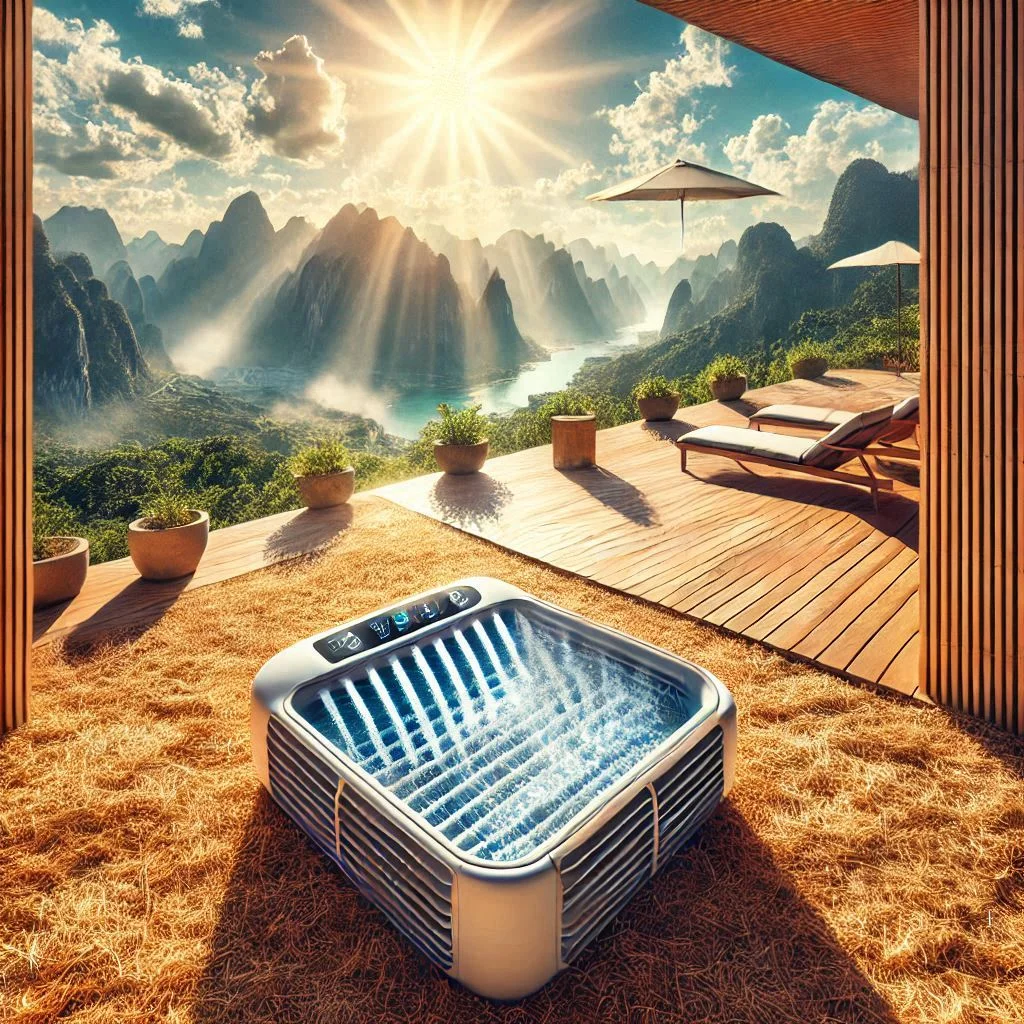
Air Conditioners
Features and Benefits of Traditional Air Conditioners for Patio Cooling
Air conditioners (ACs) are the most effective and powerful cooling solution for patios that experience extreme heat. Unlike evaporative coolers, air conditioners rely on refrigerants to cool the air, providing a much stronger cooling effect. When installed properly, air conditioners can create a comfortable and cool outdoor space, even in the hottest summer months.
How Air Conditioners Work in Outdoor Environments
Traditional air conditioners for patios are designed to cool the surrounding air by drawing in warm air, passing it over cold evaporator coils, and releasing cooled air into the environment. Some air conditioners are specifically designed for outdoor spaces and come equipped with weatherproof features to withstand the elements.
Pros of Using Air Conditioners for Patios:
- Strong Cooling Power: Air conditioners provide a consistent and powerful cooling effect, especially in areas with high heat.
- Works in All Climates: Unlike evaporative coolers, air conditioners work efficiently in both dry and humid environments.
- Precise Temperature Control: Air conditioners offer the ability to control the temperature of your patio with a thermostat, giving you complete comfort.
Cons of Using Air Conditioners for Patios:
- Higher Energy Consumption: Air conditioners are more energy-intensive compared to other cooling solutions, which can lead to higher electricity bills.
- Installation Requirements: Installing a permanent air conditioning unit may require professional installation, which can be expensive and complex.
- Less Eco-Friendly: Traditional air conditioners use refrigerants that can be harmful to the environment, though newer models are more energy-efficient and eco-friendly.
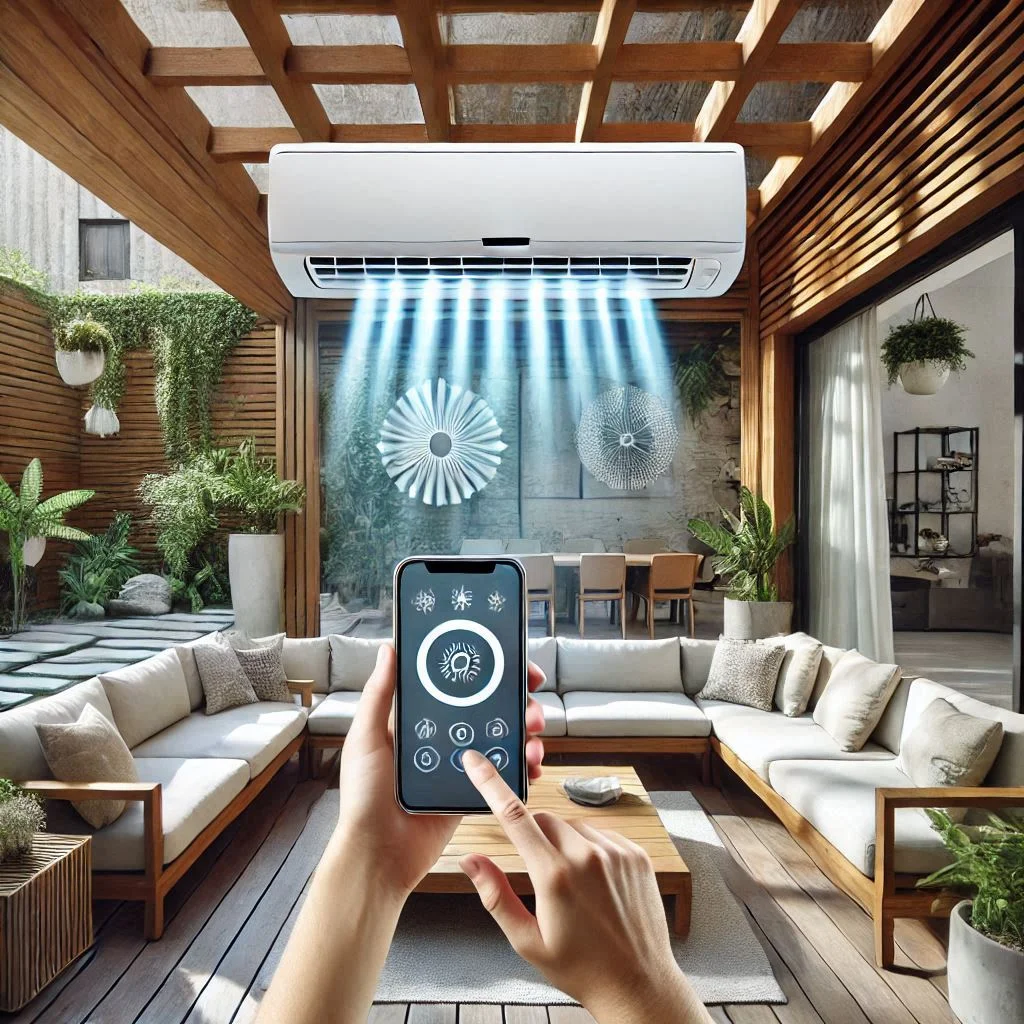
Portable Air Conditioners
Detailed Look at Portable Air Conditioners for Patios
Portable air conditioners (PACs) have become a popular choice for outdoor cooling due to their convenience, flexibility, and ease of use. These units are compact and mobile, allowing you to move them from one area to another depending on your cooling needs. Portable air conditioners are ideal for people who want to cool their patios without committing to permanent installation.
How Portable Air Conditioners Work for Patios
Portable air conditioners work in much the same way as traditional air conditioners but are smaller and easier to install. They typically require a venting hose to expel warm air and condensation, which can be routed through a window or door. These units are often designed to cool a single room or patio area and can be easily moved to different locations, making them perfect for flexible cooling.
Pros of Portable Air Conditioners for Patios:
- Mobility and Flexibility: You can easily move the unit to any part of your patio, offering customizable cooling wherever you need it.
- No Permanent Installation Needed: These units are easy to set up and don’t require professional installation.
- Ideal for Smaller Patios: Portable air conditioners are perfect for cooling small to medium-sized patio areas, especially if you don’t want a permanent installation.
Cons of Portable Air Conditioners for Patios:
- Limited Cooling Power: While portable air conditioners are effective, they generally have a lower cooling capacity compared to traditional air conditioners.
- Noise Levels: Some portable units can be noisy, which may detract from the peaceful ambiance of your patio.
- Requires Venting: Portable air conditioners need a venting system, usually a window or door, which may not be ideal for all outdoor setups.
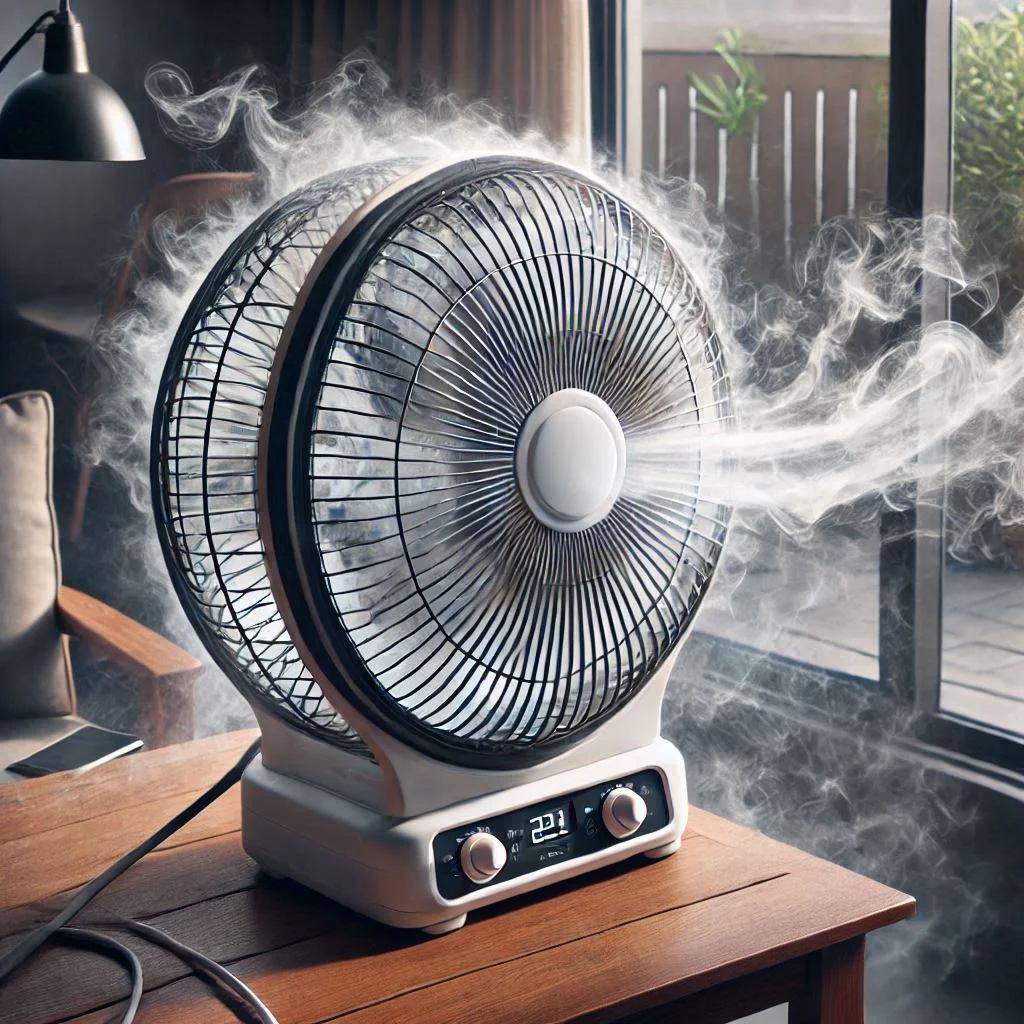
How Fans Can Complement Air Conditioning or Be Used Alone in Certain Climates
Fans are the simplest and most budget-friendly outdoor cooling solution. While fans don’t actually lower the temperature of a space, they work by circulating the air and creating a wind-chill effect that can make the environment feel cooler. In areas with moderate heat, fans can be an effective way to improve comfort.
How Fans Work for Outdoor Spaces
Fans are generally used to provide airflow, which enhances the cooling effect of other systems like air conditioners. In areas where air conditioning is not necessary or too costly, a fan can be a great alternative for creating a cool breeze.
Pros of Using Fans for Patios:
- Affordable: Fans are relatively inexpensive compared to other cooling solutions, making them a budget-friendly option.
- Energy-Efficient: Fans consume very little power compared to air conditioners, reducing electricity bills.
- Simple to Use: Fans are easy to set up and require no installation.
Cons of Using Fans for Patios:
- Limited Cooling: Fans don’t reduce the temperature but only create a breeze, which may not be sufficient during extremely hot weather.
- Ineffective in Humid Conditions: Fans can feel uncomfortable in humid climates as they don’t reduce moisture in the air.
The Best Portable Air Conditioners for Patios in 2025
As outdoor living spaces continue to grow in popularity, finding an effective and convenient cooling solution for your patio becomes essential. Portable air conditioners (PACs) are a great option for those who want flexible, powerful, and energy-efficient cooling without committing to permanent installations. In this section, we will review the top portable air conditioners for patios in 2025 and highlight the key features to consider when selecting the best model for your needs.
Top Portable Air Conditioners Suited for Patio Spaces in 2025
In 2025, portable air conditioners have evolved to become even more efficient and versatile. The models featured here are designed to provide optimal cooling for outdoor spaces, including patios, decks, and balconies. Here are some of the best options available for patio cooling:
- Honeywell MN10CESBB Portable Air Conditioner
- Cooling Capacity: 10,000 BTU
- Key Features: This model is designed for rooms up to 350 square feet, making it ideal for medium-sized patios. It comes with a built-in dehumidifier, energy-saving mode, and a washable filter for easy maintenance. The sleek, compact design ensures it fits in any patio setup without taking up too much space.
- Pros: Energy-efficient, compact design, quiet operation, multiple fan speeds.
- Cons: May require a window for venting, not ideal for large outdoor spaces.
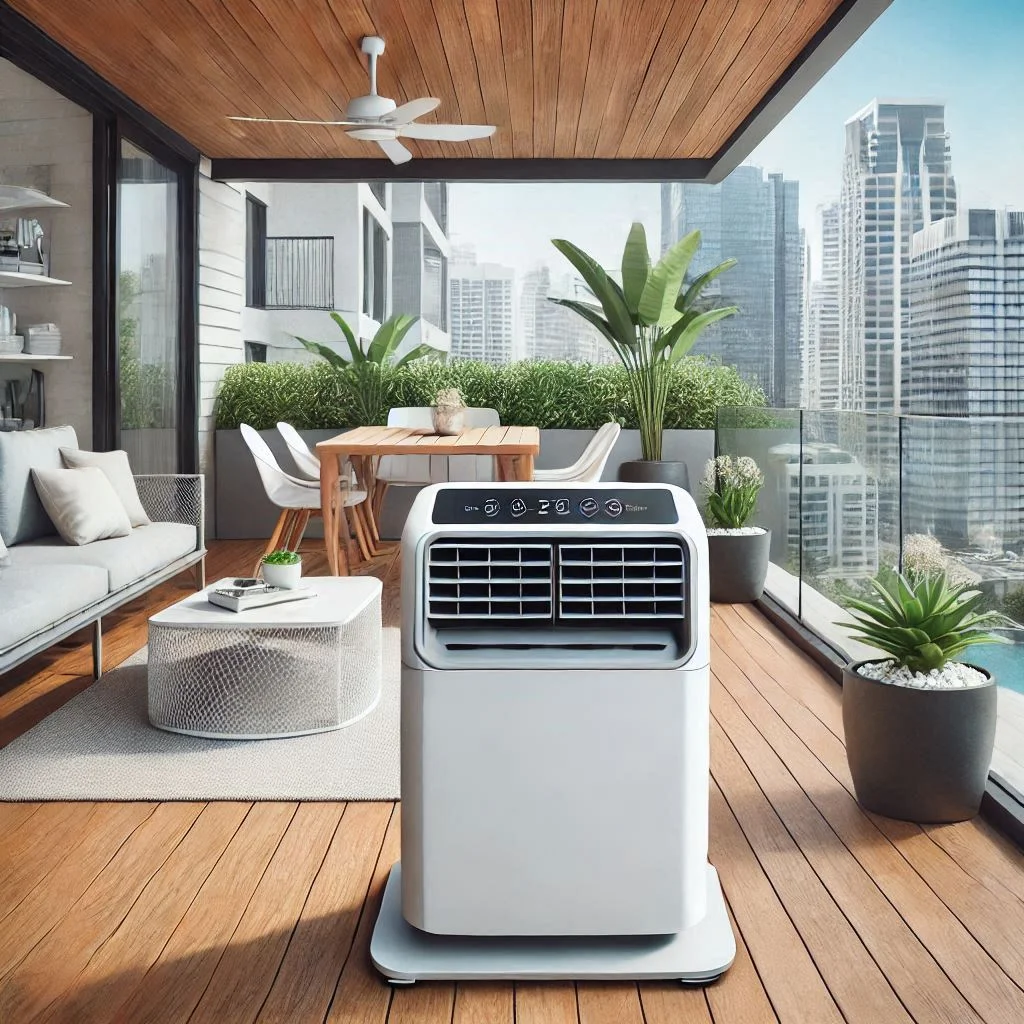
- BLACK+DECKER BPACT10WT Portable Air Conditioner
- Cooling Capacity: 10,000 BTU
- Key Features: This portable AC unit offers easy mobility with its four caster wheels and is perfect for small to medium-sized patios. It also features a three-in-one system (cooling, dehumidifying, and fan) and comes with a remote control for added convenience. The installation process is quick and easy with the included window kit.
- Pros: Versatile 3-in-1 functionality, remote control, simple installation.
- Cons: May struggle in larger patio areas or extreme heat.
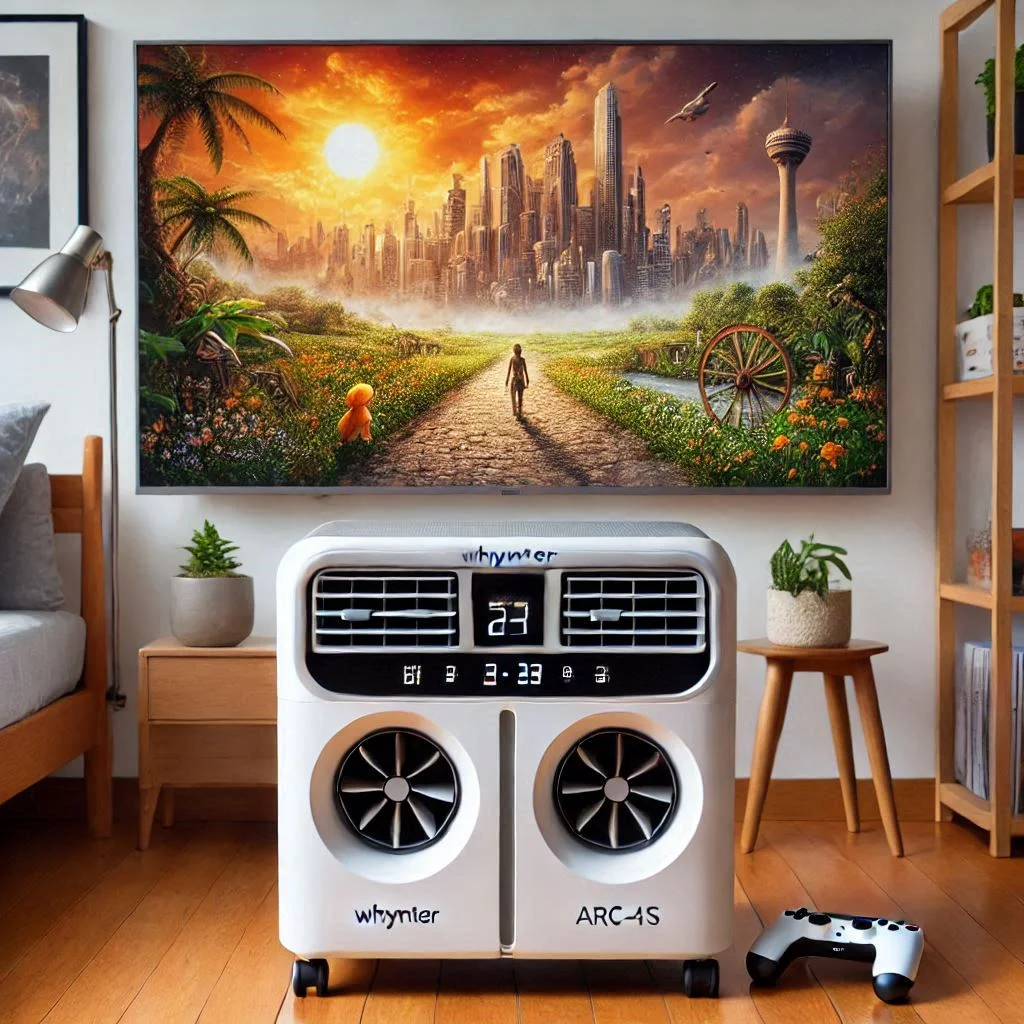
- Cooling Capacity: 14,000 BTU
- Key Features: With its powerful 14,000 BTU cooling capacity, the Whynter ARC-14S is perfect for larger outdoor areas. It features dual hoses for more efficient cooling, helping to lower temperatures more quickly while reducing energy consumption. Additionally, it comes with an auto-drain function, meaning you won’t have to worry about manual water removal.
- Pros: High cooling capacity, dual hose design for efficiency, auto-drain function, ideal for large patios.
- Cons: Larger size, higher price point.
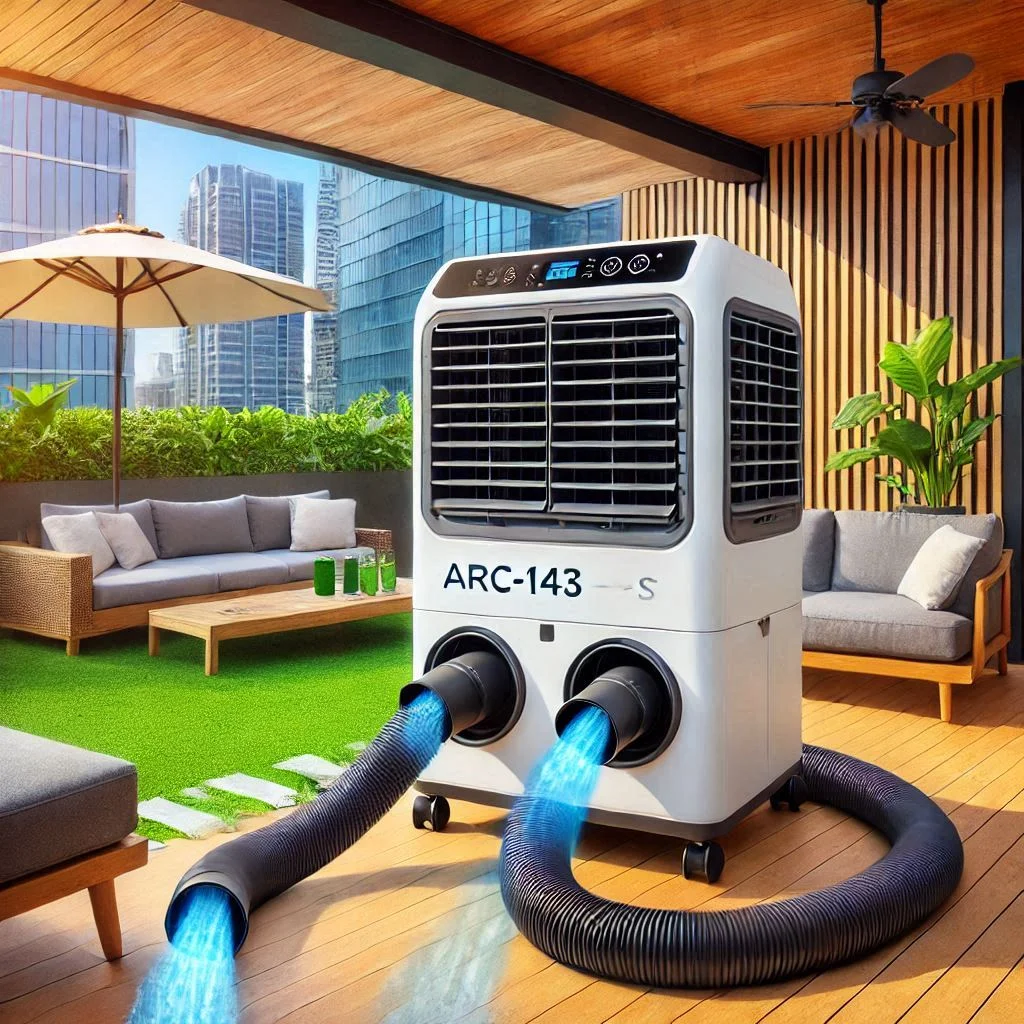
- Vornado PAC500 Portable Air Conditioner
- Cooling Capacity: 12,000 BTU
- Key Features: Known for its unique V-Flow circulation technology, the Vornado PAC500 provides uniform cooling to large patio spaces. Its 12,000 BTU capacity makes it ideal for medium to large-sized areas. The PAC500 also offers a quiet operation, allowing you to relax without the loud noise typically associated with air conditioners.
- Pros: V-Flow technology for even cooling, quiet operation, great for larger patios.
- Cons: Higher cost compared to smaller models.
Features to Consider for Outdoor Cooling
When selecting the best portable air conditioner for your patio, there are several key features to consider to ensure you get the most out of your investment. These include:
- Cooling Capacity (BTU Rating)
- The cooling capacity, measured in British Thermal Units (BTU), is crucial in determining how effectively the unit will cool your patio space. For smaller patios, a 10,000 BTU unit is often sufficient, but for larger spaces, look for models with 12,000 BTU or higher for optimal performance.
- Best for Small to Medium Patios: 10,000 BTU to 12,000 BTU
- Best for Large Patios: 14,000 BTU or more
- Energy Efficiency
- Energy efficiency is vital for reducing electricity costs while still providing strong cooling power. Look for portable air conditioners with Energy Star ratings or energy-saving modes to maximize efficiency. Some models even feature eco-friendly refrigerants, which are better for the environment.
- Noise Levels
- Since portable air conditioners work in an open outdoor space, noise can become a concern. Some units feature quieter operation modes to ensure that your patio remains a peaceful retreat. If you’re sensitive to noise, choose a model with lower decibel ratings (under 55dB is ideal for outdoor areas).
- Portability and Mobility
- One of the primary advantages of portable air conditioners is their mobility. Look for units with caster wheels for easy movement. If you want flexibility, choose a model that can be moved between different areas of your patio or even brought inside if necessary.
- Air Purification and Dehumidifying Features
- Some models come with built-in air purifiers or dehumidifiers. These additional features help improve air quality and reduce humidity, making the environment more comfortable, especially during damp weather or rainy seasons.
- Ventilation and Installation
- Most portable air conditioners require a venting hose to expel hot air. Ensure that your patio has easy access to a window or door for this purpose. Some units come with a window kit for quick installation, while others may require additional accessories.
- Dual Hose vs. Single Hose Design
- Portable air conditioners come in either single or dual hose designs. Dual hose systems are generally more efficient as they allow for faster cooling and better air circulation by venting out the hot air and drawing in cool air simultaneously.
- Remote Control and Smart Features
- Many modern portable air conditioners come equipped with remote controls, Wi-Fi connectivity, and smart app integration. These features offer added convenience, allowing you to adjust settings remotely without needing to get up from your patio chair.
The Best Portable Air Conditioners for Patios in 2025
In 2025, the demand for efficient and flexible outdoor cooling solutions continues to grow, particularly for patios and other outdoor spaces. Whether you’re hosting a gathering, relaxing outdoors, or simply enjoying the fresh air, the best portable air conditioners (PACs) for patios ensure your comfort during hot weather. These models provide a combination of portability, powerful cooling capabilities, and energy-efficient operation, making them ideal for various outdoor environments.
This article will review some of the top portable air conditioners designed for patios in 2025 and discuss the essential features to look for when purchasing one.
Top Portable Air Conditioners Suited for Patio Spaces in 2025
When selecting a portable air conditioner for your patio, it’s crucial to consider factors like cooling capacity, energy efficiency, portability, and ease of use. Below are some of the top models in 2025, perfect for your outdoor living space:
1. Honeywell MN10CESBB Portable Air Conditioner
- Cooling Capacity: 10,000 BTU
- Features: The Honeywell MN10CESBB is a highly rated portable air conditioner, designed for cooling spaces up to 350 square feet. It comes with a built-in dehumidifier, energy-saving features, and a washable filter for easy maintenance. The sleek, modern design allows it to blend seamlessly into your patio decor.
- Pros:
- Energy-efficient and quiet
- Easy to set up and operate
- Portable with built-in wheels
- Cons:
- Requires a window for venting
- May not be powerful enough for larger patios
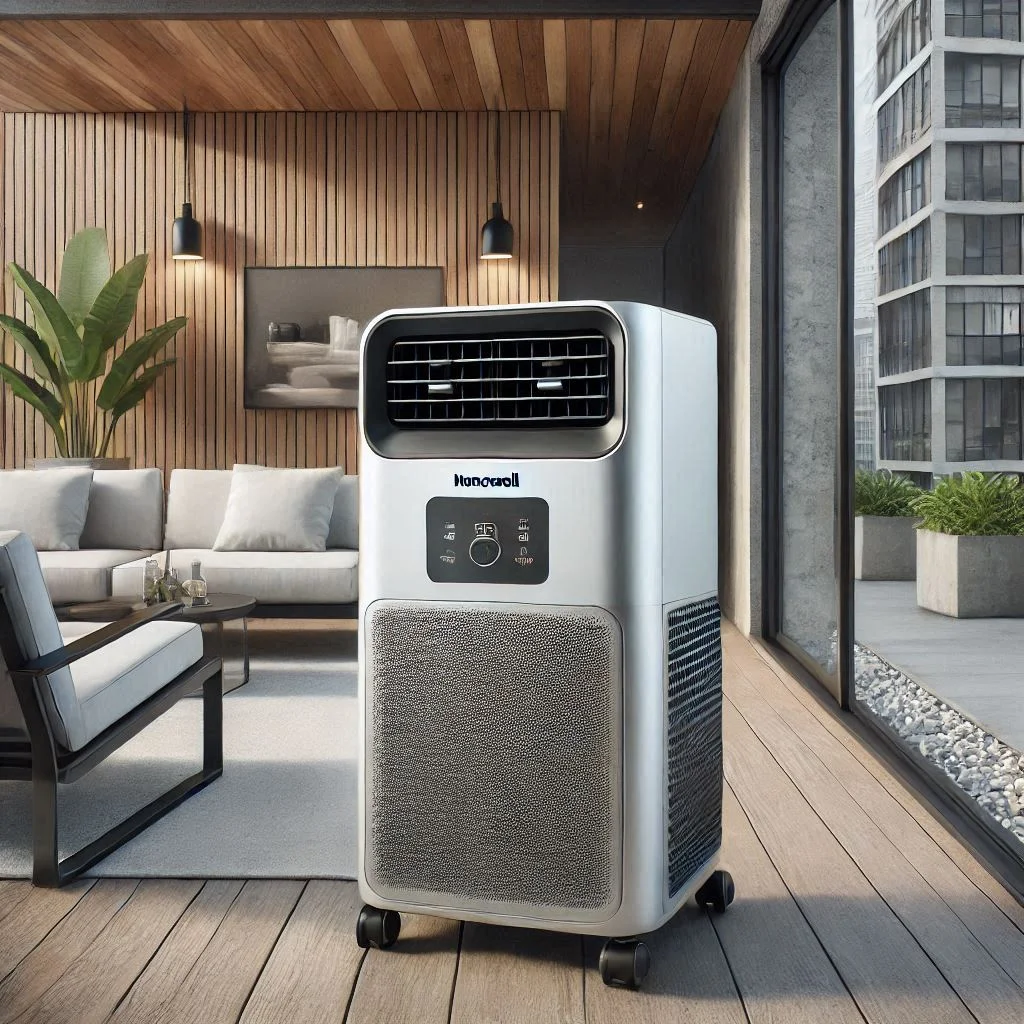
2. BLACK+DECKER BPACT10WT Portable Air Conditioner
- Cooling Capacity: 10,000 BTU
- Features: This unit is ideal for smaller to medium-sized patios. It combines cooling, dehumidifying, and fan functions in one device. It features easy installation with an included window kit, and it can be controlled remotely for added convenience.
- Pros:
- Versatile 3-in-1 functionality
- Simple installation with window kit
- Remote control for convenience
- Cons:
- May not cool large outdoor spaces effectively
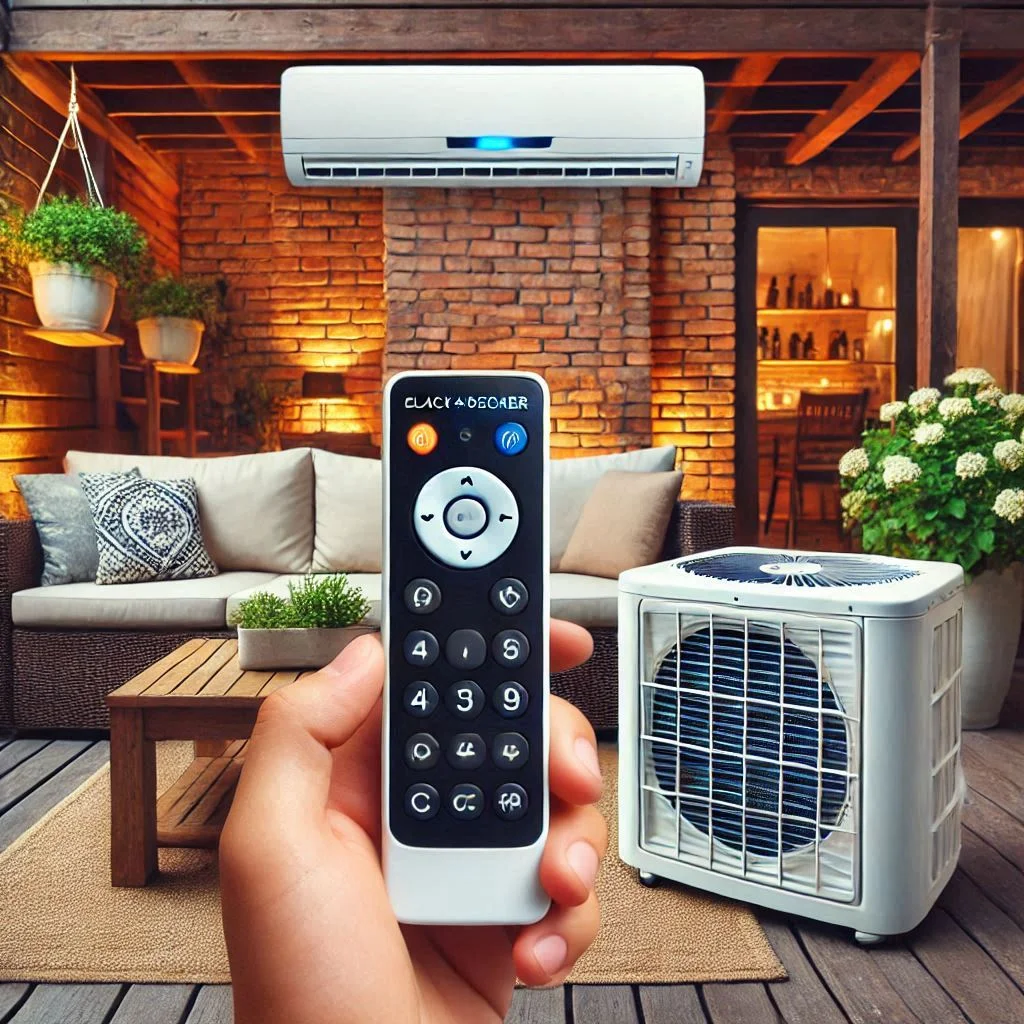
3. Whynter ARC-14S Dual Hose Portable Air Conditioner
- Cooling Capacity: 14,000 BTU
- Features: Perfect for larger patios, the Whynter ARC-14S is a powerful 14,000 BTU portable air conditioner. It features a dual-hose system for more efficient cooling and a self-evaporating feature, meaning no water removal is required. The auto-drain function helps reduce maintenance efforts.
- Pros:
- High cooling capacity, perfect for large patios
- Dual hose design for efficient cooling
- Self-evaporating feature reduces maintenance
- Cons:
- Larger size requires more space
- Higher price point compared to smaller models
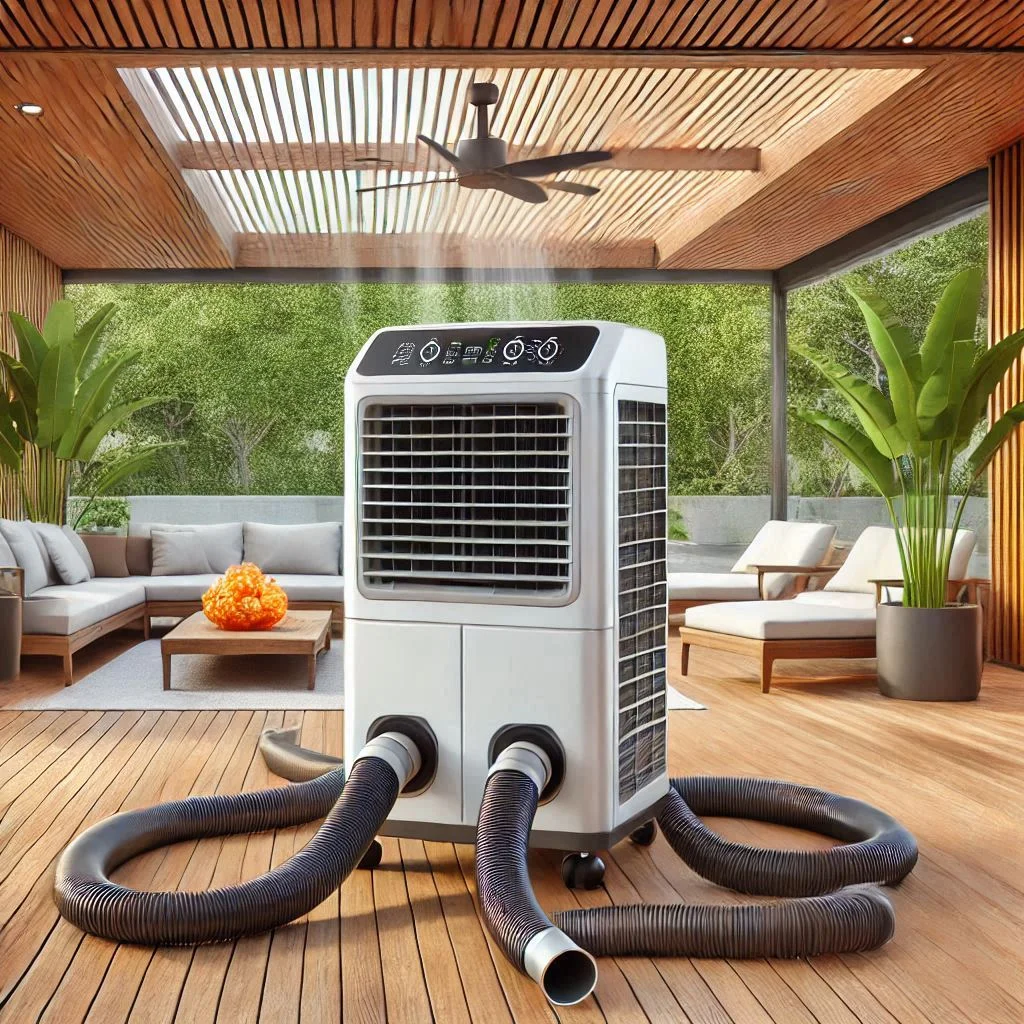
4. Vornado PAC500 Portable Air Conditioner
- Cooling Capacity: 12,000 BTU
- Features: The Vornado PAC500 offers uniform cooling with its V-Flow circulation technology. This model is designed to cool larger patios effectively, providing balanced air distribution. It operates quietly, making it perfect for a peaceful outdoor setting.
- Pros:
- Even cooling with V-Flow technology
- Quiet operation, great for relaxation
- Ideal for medium to large outdoor areas
- Cons:
- Higher cost for the advanced technology
Features to Consider for Outdoor Cooling
When purchasing a portable air conditioner for your patio, understanding the key features and specifications is essential to selecting the right model for your needs. Here are the top features to keep in mind when choosing the best portable air conditioner for patio spaces:
1. Cooling Capacity (BTU Rating)
- The cooling capacity of an air conditioner is measured in BTUs (British Thermal Units). For a small to medium patio, a unit with a 10,000–12,000 BTU rating is usually sufficient. For larger patios or extremely hot weather, opt for models with 14,000 BTU or more.
- Tip: Match the cooling capacity to the size of your outdoor space for optimal performance.
2. Energy Efficiency
- Energy-efficient air conditioners help keep your electricity bill down while maintaining optimal cooling performance. Look for units with an Energy Star rating or energy-saving features like automatic shut-off and eco-mode.
- Tip: Consider air conditioners with built-in energy-saving features for long-term cost savings.
3. Noise Levels
- Noise can be an issue when using an air conditioner in an open outdoor space. Look for models that operate quietly, with decibel ratings under 55dB. This ensures that your patio remains peaceful while you enjoy the cool air.
- Tip: Check the manufacturer’s noise specifications before purchasing.
4. Portability and Mobility
- One of the biggest advantages of portable air conditioners is their ability to be moved from one location to another. Look for units with caster wheels for easy mobility, especially if you want to move the air conditioner between different areas of your patio.
- Tip: Choose a model with built-in handles or wheels for added portability.
5. Ventilation Requirements
- Most portable air conditioners require a venting system to expel warm air outside. Ensure your patio has a window or door nearby to accommodate the vent hose. Some models come with a window kit for easy installation.
- Tip: Check whether the unit includes a window kit or additional accessories to make installation easier.
6. Additional Features
- Some portable air conditioners come with extra features like built-in air purifiers, dehumidifiers, or smart controls. These features can enhance the air quality and comfort on your patio.
- Tip: Consider air conditioners with multiple functions, especially if you’re in a humid area.
Key Factors to Consider When Choosing an Outdoor AC for Your Patio
Choosing the right outdoor air conditioner (AC) for your patio is a crucial decision that can significantly affect your comfort and energy efficiency. There are several important factors to consider when selecting a unit, including cooling capacity (BTU), noise levels, and energy efficiency. In this guide, we’ll help you understand these key factors and how to choose the ideal portable AC for your outdoor space in 2025.
Understanding BTU and Cooling Capacity
BTU, or British Thermal Units, measures the cooling capacity of an air conditioner. The higher the BTU rating, the more powerful the AC is, and the larger the area it can cool. It’s vital to choose an AC unit that aligns with the size of your patio for optimal performance. Selecting an air conditioner with too few BTUs can result in inadequate cooling, while one with too many BTUs may waste energy.
How to Calculate the Right BTU for Your Patio
To find the right BTU, you’ll need to consider the size of your patio and the outdoor climate. A general rule of thumb is:
- Small Patio (Up to 200 sq. ft.): 8,000 – 10,000 BTU
- Medium Patio (200-400 sq. ft.): 10,000 – 12,000 BTU
- Large Patio (400 sq. ft. or more): 14,000+ BTU
Tip: Always err on the side of selecting a slightly higher BTU rating for better efficiency, especially if your patio faces direct sunlight.
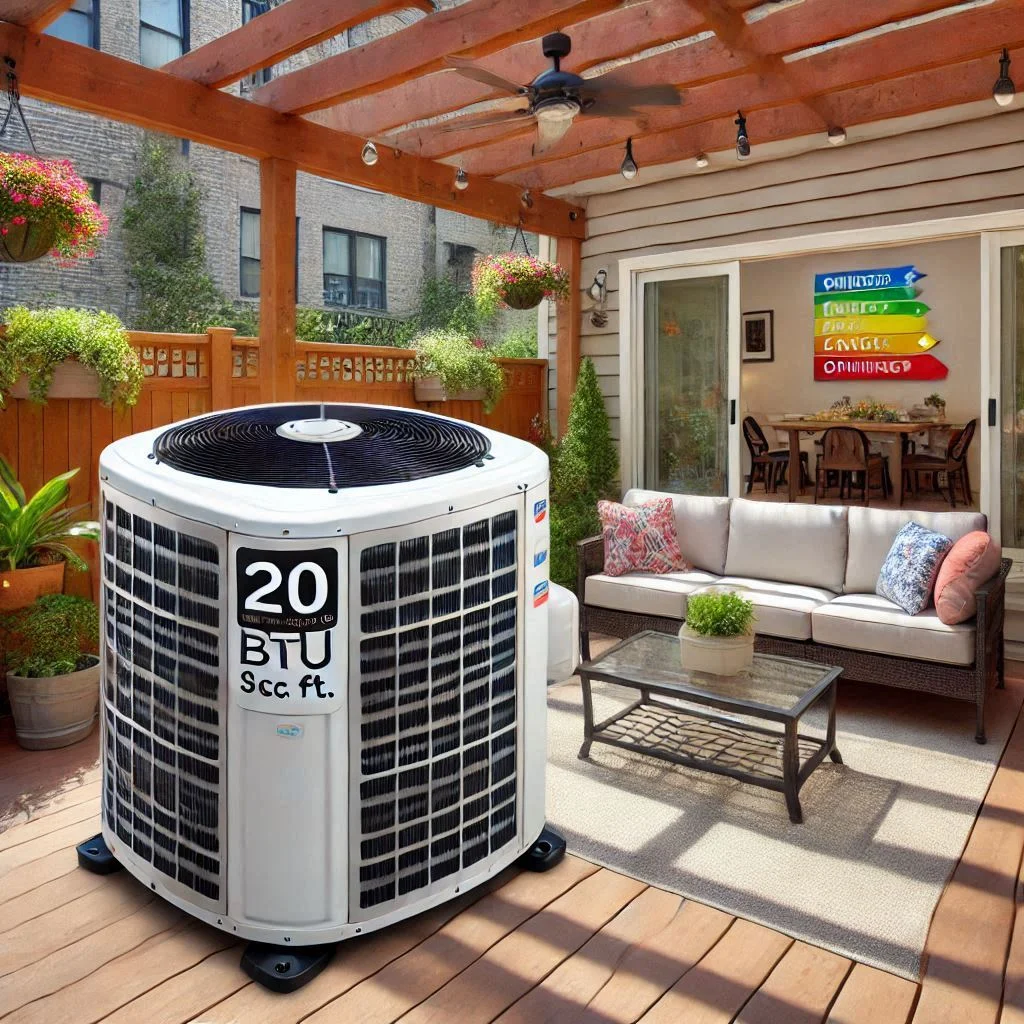
Noise Levels of Outdoor Air Conditioners
Noise is one of the most important considerations when selecting an outdoor air conditioner. The last thing you want is to have your peaceful outdoor setting disturbed by loud air conditioning. The noise level of an AC unit is measured in decibels (dB). For outdoor spaces, a quieter unit is usually better, as you’ll likely be entertaining guests or relaxing in a calm environment.
What Noise Levels Should You Look For?
- Below 55 dB: Ideal for a quiet, comfortable outdoor setting.
- 55 dB – 65 dB: Slightly louder, but still manageable for outdoor spaces.
- Above 65 dB: Generally too loud and disruptive for patios.
Tip: Look for air conditioners with noise-reducing technology or those designed specifically for quieter operation.
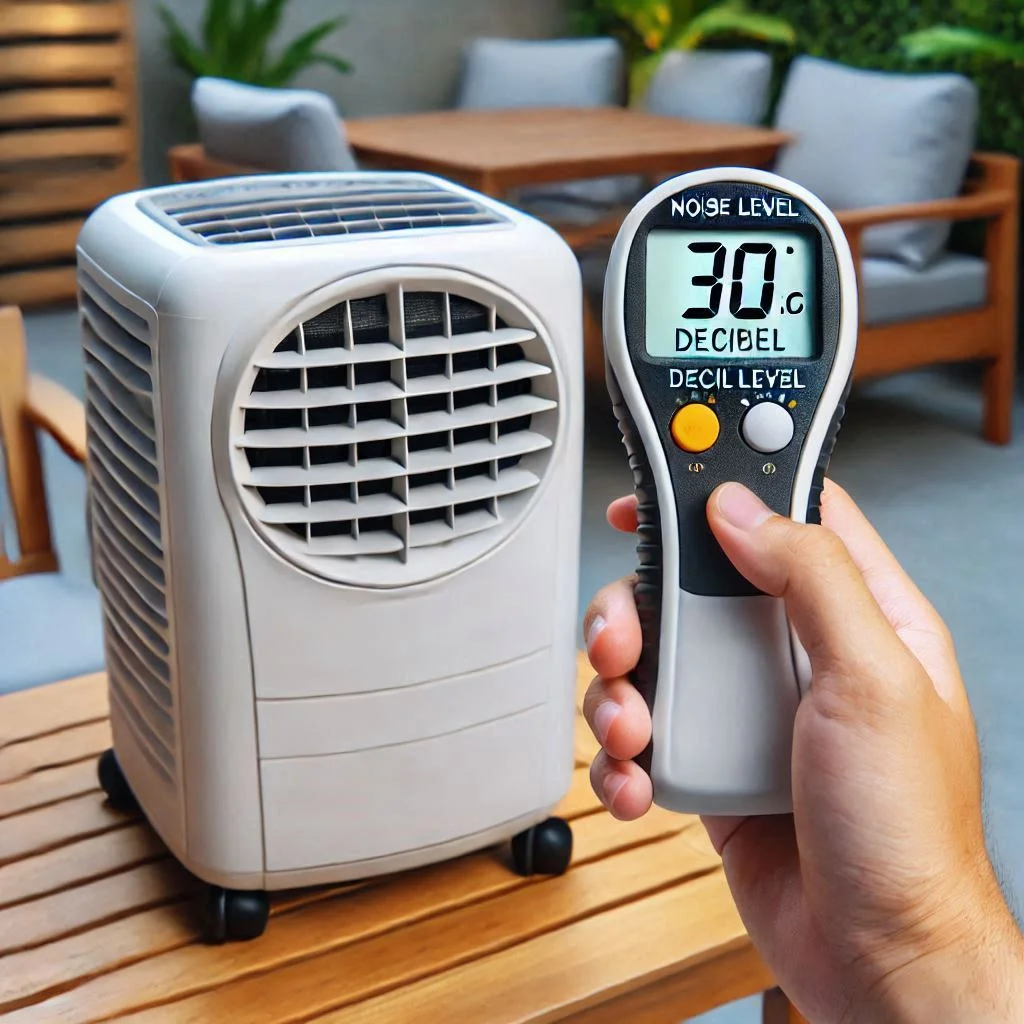
Energy Efficiency and Cost Savings
Energy efficiency is one of the top concerns for homeowners. Outdoor air conditioners can run for long hours, especially during the hotter months, so choosing a unit that is energy-efficient can save you money in the long run. Many air conditioners today come with Energy Star ratings or features designed to reduce power consumption while still providing excellent cooling.
Why is Energy Efficiency Important?
- Lower Electricity Bills: More efficient ACs consume less power, reducing your monthly energy costs.
- Environmental Impact: Energy-efficient units consume less power, which means less strain on the grid and a smaller carbon footprint.
- Long-Term Savings: Though energy-efficient units may have a higher initial cost, they save you money over time with reduced energy consumption.
How to Choose an Energy-Efficient Outdoor AC
- Look for units with Energy Star ratings to ensure you’re getting the most efficient product.
- Consider models with eco-modes or smart thermostats that automatically adjust the temperature based on your needs.
- Check the EER (Energy Efficiency Ratio), which indicates how much cooling power a unit uses compared to its energy consumption.
Tip: Investing in an energy-efficient model may cost a bit more initially but will provide significant savings over time.
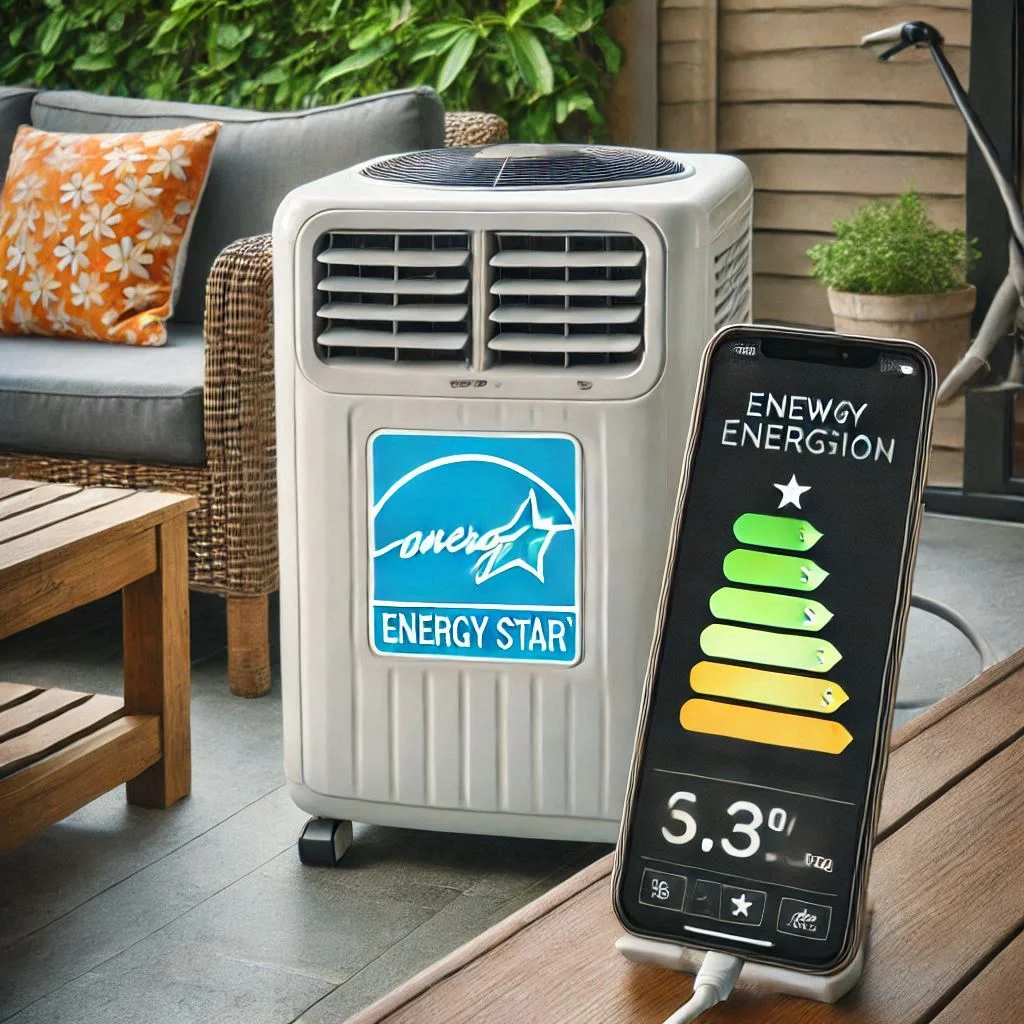
Size and Portability of the Unit
One of the advantages of portable air conditioners is their mobility. You can move them around your patio or other outdoor areas as needed. However, it’s essential to consider the size and portability of the unit to ensure it fits your space.
Choosing the Right Size for Your Patio
- Compact Models: Ideal for smaller patios or balconies where space is limited. These units are usually more portable but may have lower cooling capacities.
- Larger Models: Suitable for larger patios, these models are typically heavier but provide more cooling power. Consider whether your patio has enough space for a larger unit.
- Portable Features: Ensure the unit has caster wheels or handles for easy movement, especially if you need to reposition the AC to cool different areas.
Tip: Consider a model with adjustable airflow directions for more targeted cooling across your entire patio space.
How to Use Portable Air Conditioners for Outdoor Spaces Effectively
Portable air conditioners are a fantastic solution for keeping outdoor spaces cool and comfortable. However, to maximize their efficiency and longevity, proper usage, maintenance, and placement are essential. This guide will provide valuable tips on how to use and maintain portable air conditioners in outdoor settings, ensuring they operate at their best while also being energy-efficient.
1. Proper Placement of Your Portable AC for Maximum Cooling Efficiency
Placement plays a pivotal role in the cooling efficiency of portable air conditioners, especially in outdoor spaces. If your unit is not positioned correctly, it could struggle to cool the area effectively, wasting both energy and time. Here’s how to optimize placement:
How to Choose the Right Spot
- Away from Direct Sunlight: Avoid placing the AC in direct sunlight. Sun exposure increases the unit’s workload and reduces cooling efficiency. If possible, place the AC in a shaded area, or use a canopy to provide extra protection from the sun.
- Open Space for Airflow: Portable air conditioners need good airflow to work efficiently. Make sure the unit is not obstructed by furniture, walls, or large plants. Keep a minimum distance of 3 feet from walls or large objects to allow air circulation.
- Near an Exhaust Vent: If the unit requires venting, ensure there is an accessible window or vent to expel warm air outside. You can use venting kits or window kits to direct the warm air outside.
- Consider the Size of the Area: Ensure the AC is placed centrally to maximize airflow and evenly distribute cool air throughout the outdoor space. This prevents certain areas from being too cold while others remain too warm.
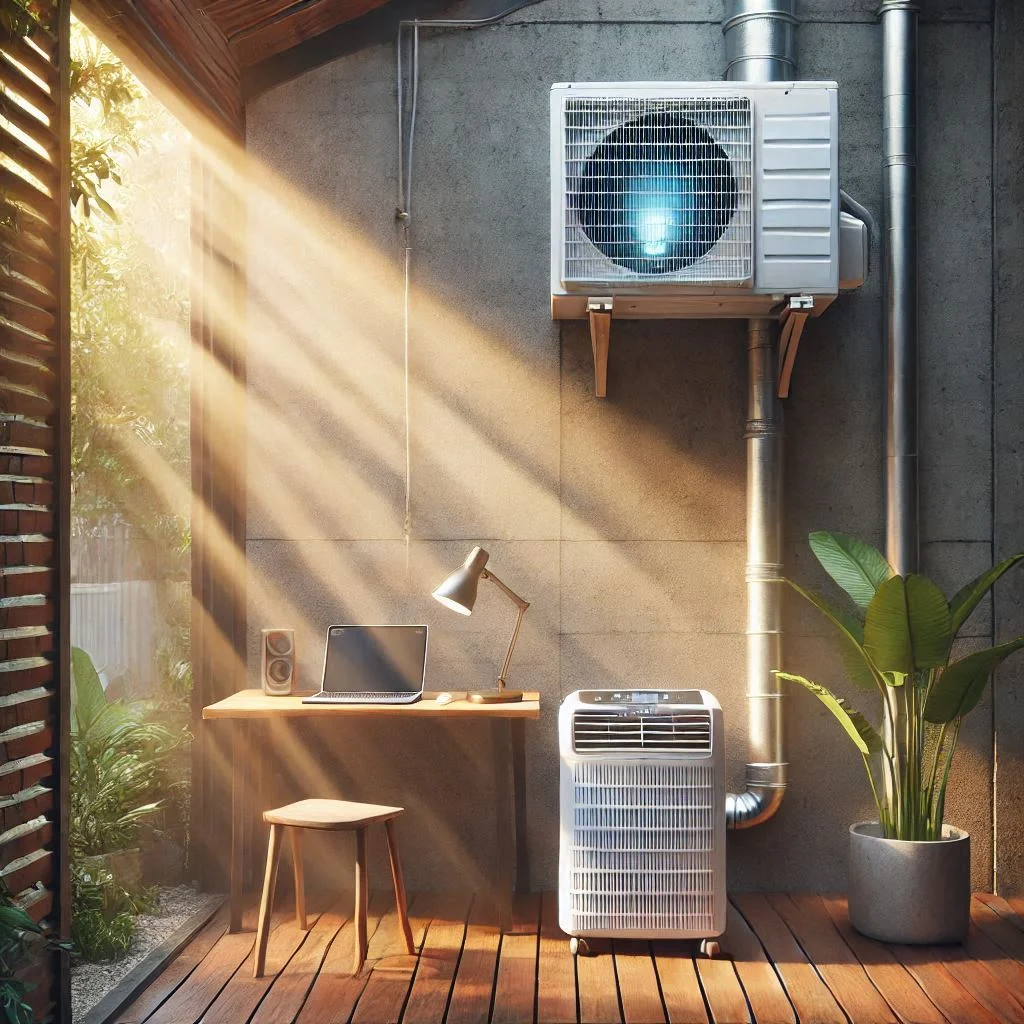
2. Ventilation and Exhaust Considerations for Outdoor Use
One of the most important aspects of using portable air conditioners outdoors is ensuring proper ventilation. These units need to expel warm air effectively, especially in enclosed or semi-enclosed spaces like patios or porches. Without proper exhaust, the cooling performance will be compromised.
How to Ventilate Effectively
- Use a Venting Kit: Most portable air conditioners come with venting kits that can be installed in a window or door. These kits typically include hoses that allow the hot air to be vented outside, ensuring the cooling process is more efficient.
- Ensure Tight Seals: When using venting kits, make sure the connection is tight and secure to prevent warm air from leaking back into the space. Gaps can reduce cooling efficiency and waste energy.
- Avoid Blocking the Exhaust Hose: Ensure the hose is not kinked or obstructed, as this can cause back pressure that reduces the unit’s cooling ability.
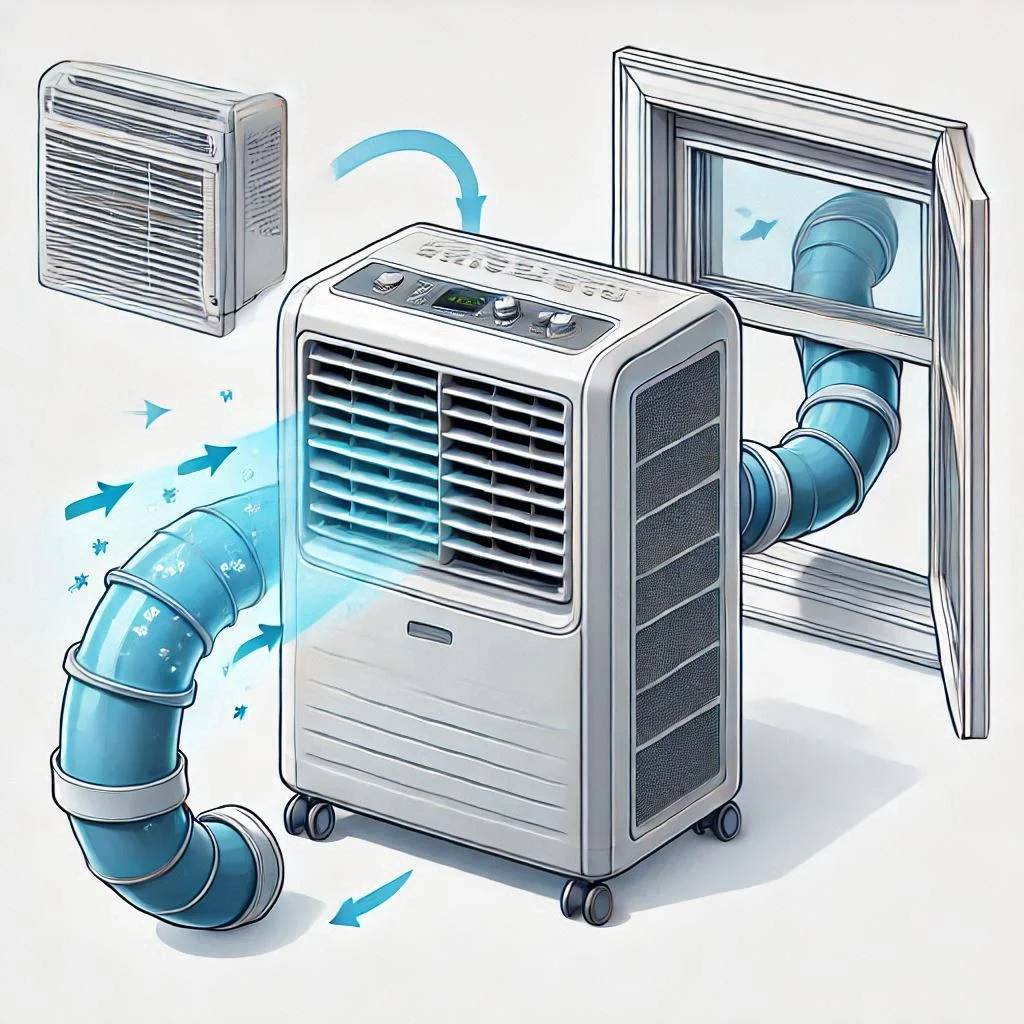
3. Tips for Energy Efficiency in Outdoor AC Usage
Running a portable air conditioner in an outdoor setting can consume significant energy, especially in hotter climates. To reduce energy consumption while maintaining a comfortable outdoor environment, consider the following tips:
Energy-Saving Tips
- Choose an Energy-Efficient Model: Look for portable air conditioners with an Energy Star rating or eco-friendly settings to reduce electricity consumption.
- Use Eco Modes: Many modern portable AC units come with an eco-mode that adjusts the cooling power based on the room temperature, helping to save energy. Make use of this setting when cooling your patio.
- Keep the Area Insulated: If your patio is attached to the house, ensure that doors and windows are closed to prevent hot air from entering. You can also use outdoor curtains or blinds to shield your space from direct sunlight, reducing the amount of cooling needed.
- Turn Off When Not in Use: If you’re not using your outdoor space, turn off the AC to save energy. Additionally, setting timers or using smart plugs that automatically turn off the unit after a set time can help conserve energy.
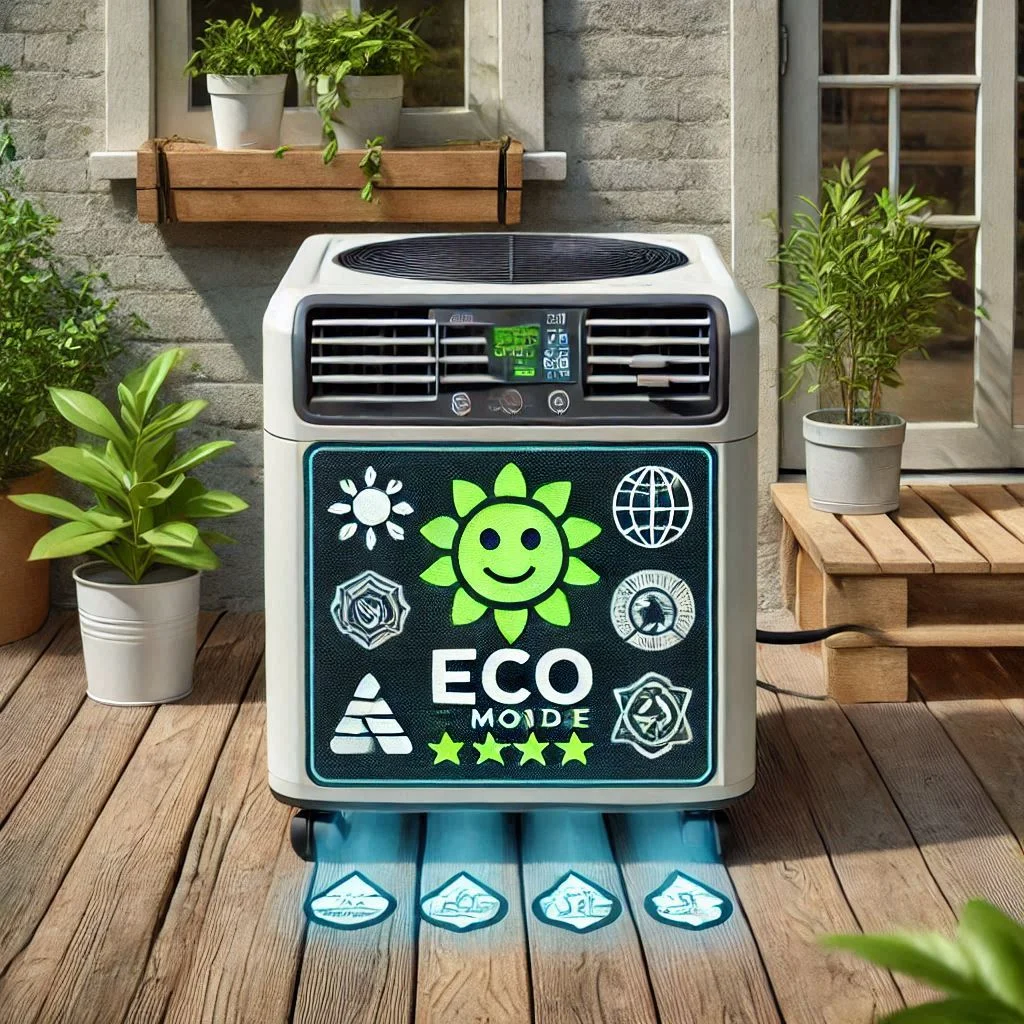
4. Regular Maintenance for Long-Term Performance
Maintaining your portable air conditioner is essential to ensure it operates efficiently and lasts for years. Outdoor conditions can affect the unit more than indoor settings, so regular care is necessary.
Maintenance Tips for Outdoor Use
- Clean the Air Filter Regularly: Air filters trap dirt and dust, and over time, they can get clogged, reducing airflow and cooling efficiency. Clean or replace the air filter regularly to ensure optimal performance.
- Check the Venting System: Ensure that the exhaust hose remains clear and unobstructed. Check it for any debris or blockages that may restrict airflow.
- Inspect for Leaks: Check for refrigerant leaks periodically. A decrease in refrigerant can drastically reduce cooling efficiency. If you notice any drop in performance, it may be a sign of a refrigerant leak.
- Store Properly in the Off-Season: If you live in an area with colder seasons, store your portable air conditioner in a dry, cool place when not in use. Cover the unit to protect it from dust and moisture.
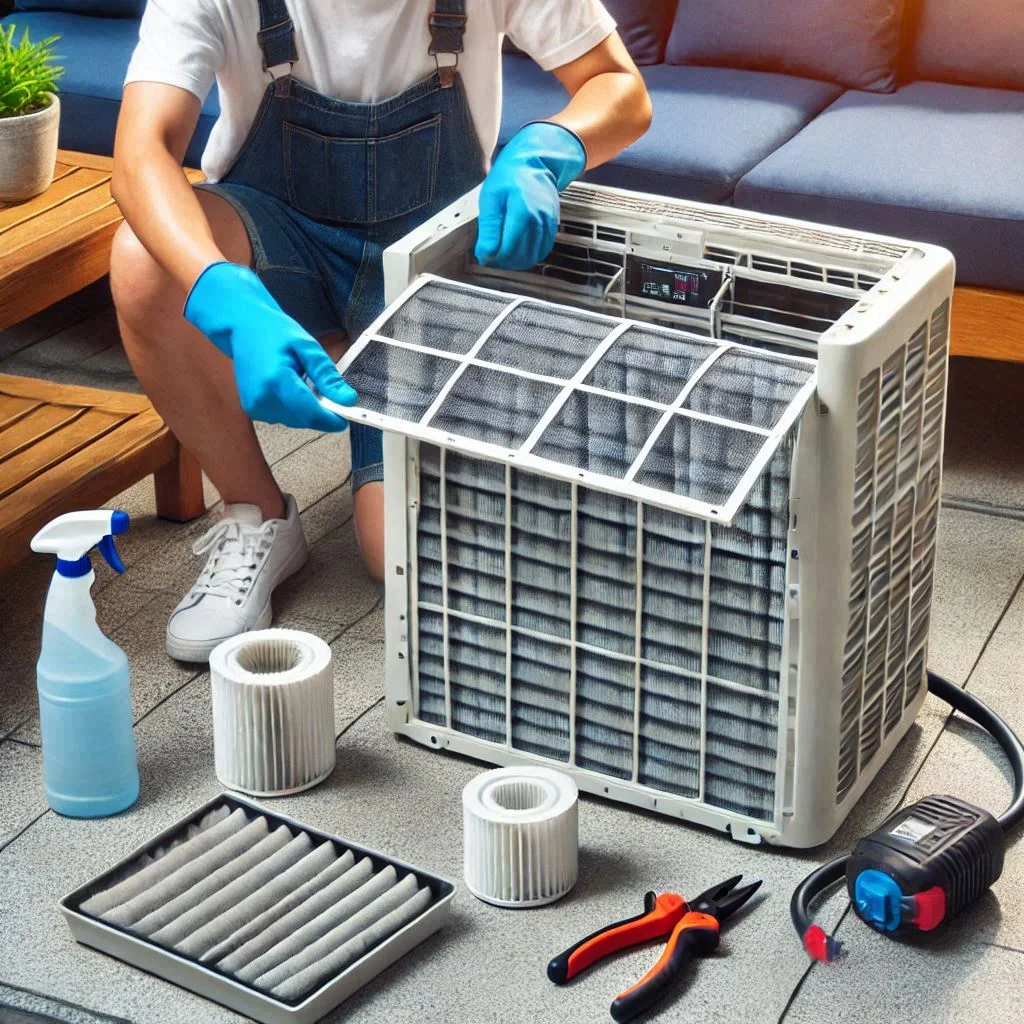
5. Using Portable Air Conditioners in Combination with Other Cooling Methods
While portable air conditioners are great at cooling outdoor spaces, you can enhance their performance by combining them with other cooling methods.
Hybrid Cooling Methods
- Use Fans Along with the AC: Placing fans around the portable air conditioner can help circulate the cool air more evenly across your patio. This helps avoid hot spots and provides more consistent cooling.
- Shade and Outdoor Curtains: Use outdoor curtains or pergolas to create shaded areas. This will reduce the overall temperature of your patio and allow the air conditioner to cool more efficiently.
- Mist Fans or Evaporative Coolers: In particularly hot or humid climates, mist fans or evaporative coolers can be used alongside portable air conditioners to create a cool breeze. These systems work by adding moisture to the air, which can reduce the perceived temperature.
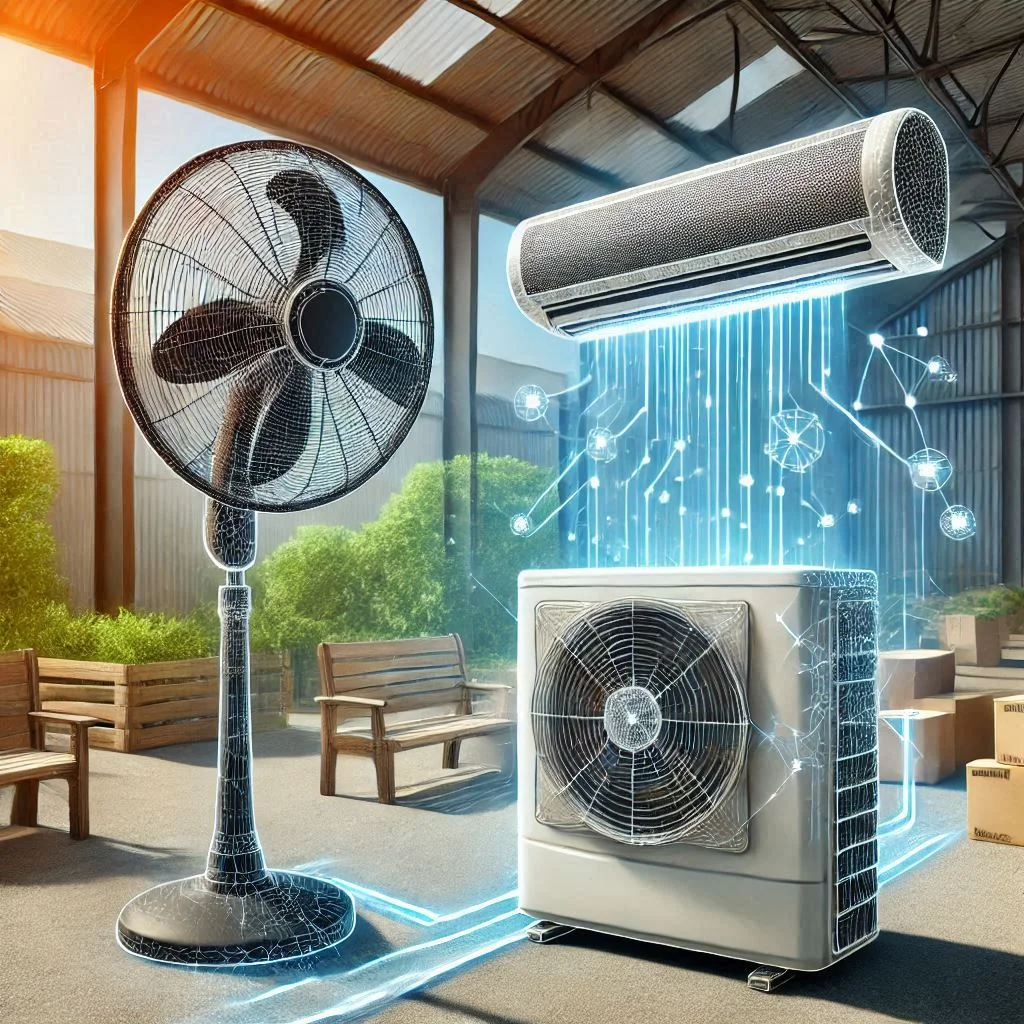
Jackery Solar Generators and Outdoor Air Conditioners: A Perfect Pairing
In the quest for sustainable living and off-grid solutions, pairing portable air conditioners with solar generators like the Jackery Solar Generator is becoming a highly popular choice for outdoor cooling. This combination offers not only comfort in outdoor spaces but also provides an eco-friendly, energy-efficient, and portable solution for cooling on the go. Let’s explore why combining solar-powered generators with outdoor air conditioners is a perfect pairing for those seeking independence from traditional power grids.
The Growing Need for Sustainable Outdoor Cooling Solutions
As outdoor living spaces become more prevalent in modern homes, the demand for reliable and sustainable cooling solutions continues to rise. While portable air conditioners are highly effective at cooling patios, balconies, and other outdoor spaces, they traditionally rely on a power source from the grid. In areas where access to reliable power is limited or during power outages, pairing a portable air conditioner with a solar generator offers an ideal solution for off-grid cooling.
Why Use Solar Power for Outdoor Cooling?
- Independence from the Grid: Solar generators provide an independent energy source, allowing you to cool your outdoor spaces without relying on traditional electricity. This is particularly beneficial for people who live in remote areas or enjoy camping.
- Eco-Friendly: Solar power is renewable and produces zero emissions, making it a sustainable alternative to traditional electricity that may be generated from non-renewable sources.
- Cost-Effective in the Long Run: While solar generators require an initial investment, they can save you money on electricity bills over time. Solar energy harnesses the power of the sun, a free and abundant resource.
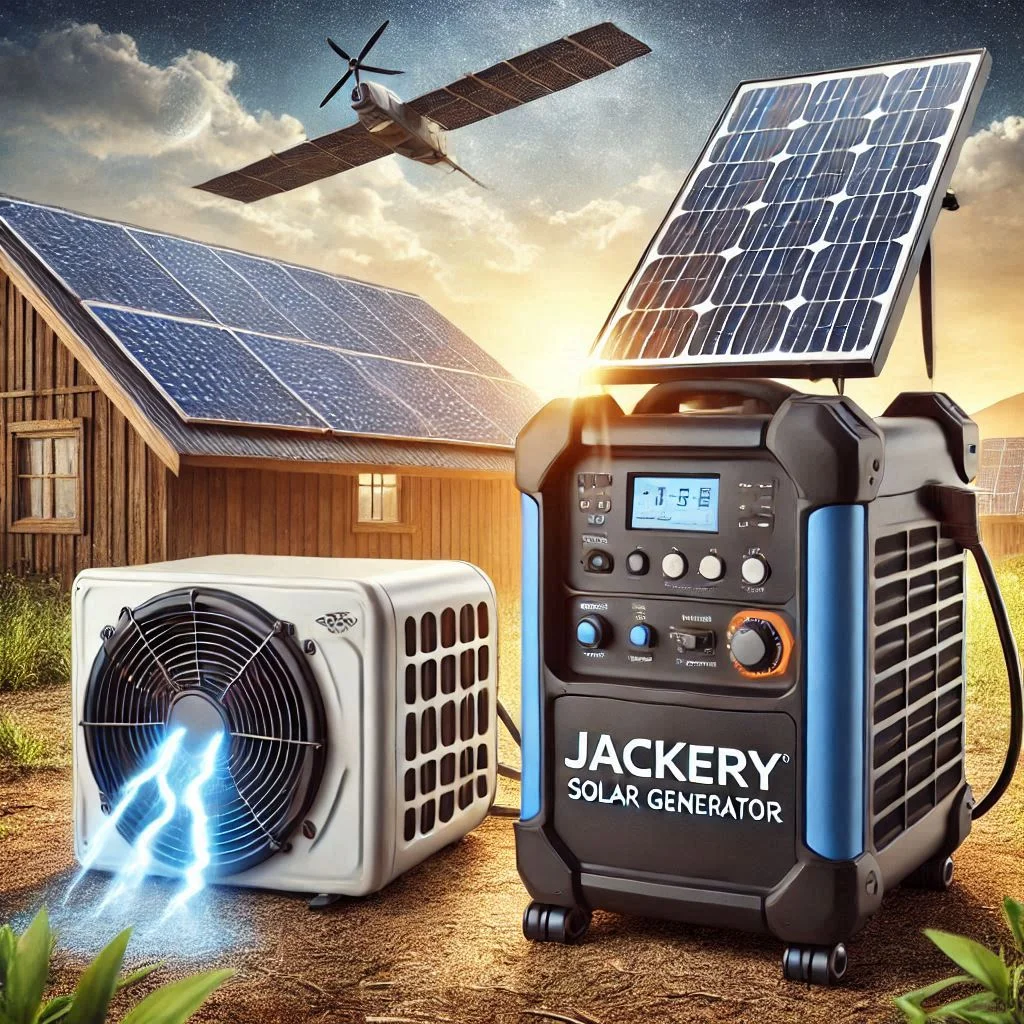
Jackery Solar Generators: Reliable Power for Outdoor Air Conditioning
The Jackery Solar Generator is an advanced, portable power station designed for off-grid use. When paired with outdoor air conditioners, these solar generators provide a reliable and eco-friendly power source. Let’s dive deeper into why Jackery Solar Generators are an excellent choice for powering your portable AC units.
Key Features of Jackery Solar Generators:
- High Battery Capacity: Jackery Solar Generators come with varying capacities, allowing you to select a model based on the cooling needs of your outdoor space. The larger the battery capacity, the longer it can power an air conditioner.
- Easy-to-Use Design: With intuitive interfaces and user-friendly designs, Jackery solar generators are easy to set up and operate, even for individuals who are not familiar with solar energy systems.
- Multiple Output Options: Jackery generators come with various output ports, including AC, DC, and USB, allowing you to power not only your portable air conditioner but also other outdoor devices, like lights and appliances.
- Portability: With built-in wheels and handles, these generators are portable and easy to transport to different outdoor locations, whether for camping, tailgating, or backyard parties.
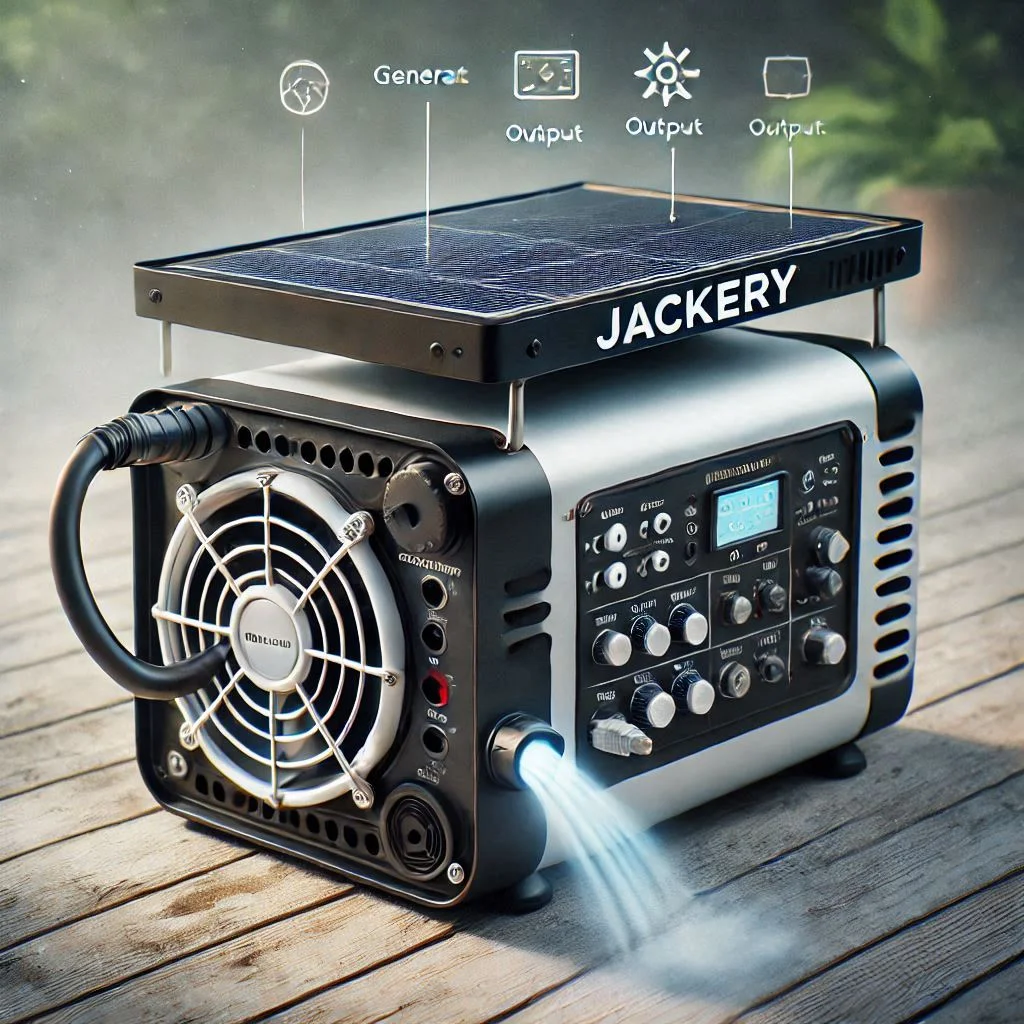
Pairing a portable air conditioner with a Jackery Solar Generator offers several key benefits for outdoor cooling, including enhanced energy independence, lower environmental impact, and overall convenience.
Enhanced Energy Independence
By using solar power, you’re no longer dependent on grid electricity to run your outdoor AC unit. Whether you’re camping, hosting an outdoor event, or simply relaxing on your patio, the Jackery Solar Generator allows you to stay cool without worrying about power cuts or increasing energy bills.
Eco-Friendly Cooling
Solar power is a renewable energy source, which means it doesn’t contribute to greenhouse gas emissions or other pollutants that are often associated with traditional electricity generation. This makes it a perfect solution for those looking to reduce their carbon footprint while enjoying the comforts of air conditioning outdoors.
Long-Term Savings
Although there is an upfront cost associated with purchasing a Jackery Solar Generator, the long-term savings are substantial. Once installed, solar generators have minimal operating costs and provide free power for years, saving you money on electricity bills. Over time, this makes the investment in a solar-powered air conditioning system very cost-effective.
Portable and Convenient
Solar generators are highly portable, making them ideal for off-grid adventures. Whether you’re at a remote campsite, hosting a barbecue, or enjoying a quiet afternoon on your porch, the ability to move the generator with ease means you can stay cool wherever you go.
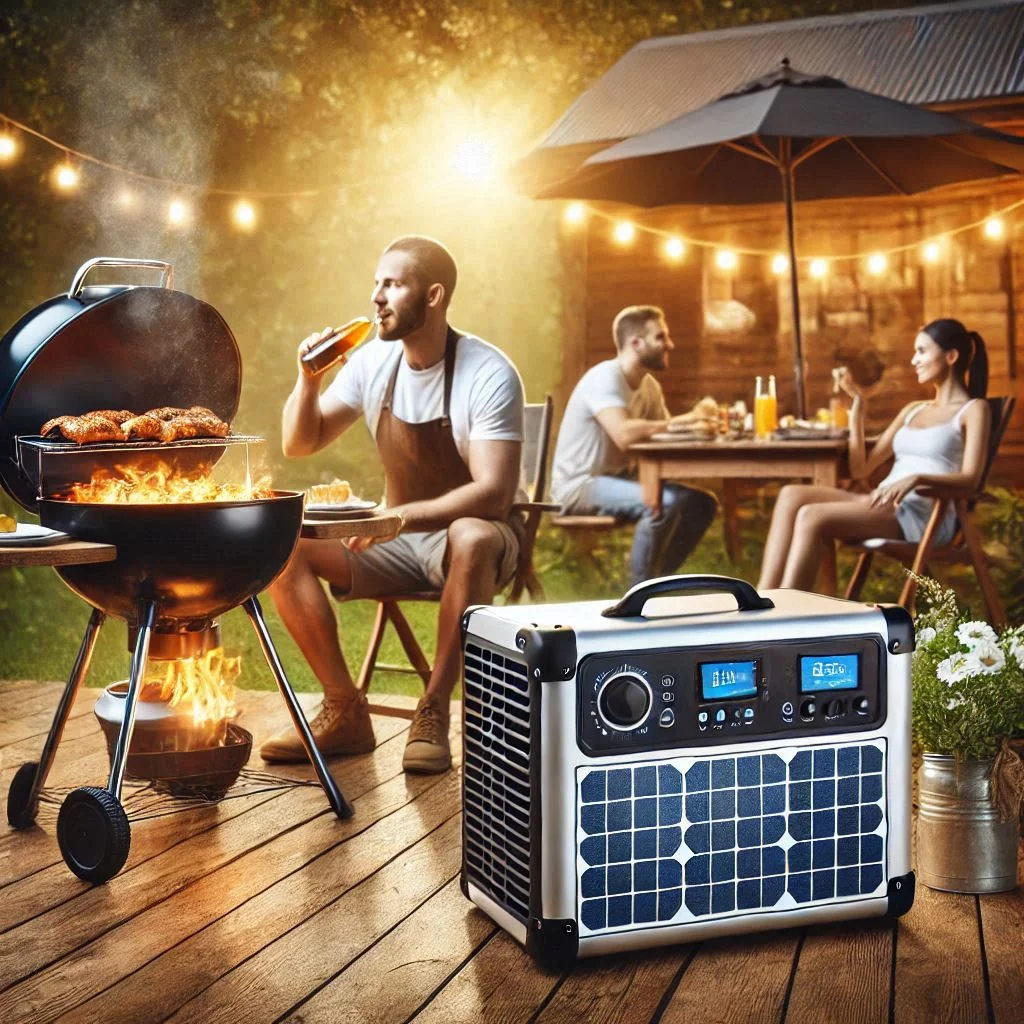
How to Pair a Jackery Solar Generator with Your Outdoor Air Conditioner
Setting up a Jackery Solar Generator to power your portable air conditioner is a simple process, but there are a few important steps to ensure everything is working optimally. Here’s a step-by-step guide on how to use the Jackery Solar Generator for outdoor cooling:
1. Choose the Right Generator Size
Select a Jackery Solar Generator model with enough battery capacity to handle your portable air conditioner’s power requirements. For example:
- Jackery Explorer 1000: Suitable for smaller to medium-sized AC units, typically for use in smaller outdoor spaces or during short cooling periods.
- Jackery Explorer 1500 or 2000: Best for larger AC units or longer cooling sessions in larger outdoor areas.
2. Set Up the Solar Panels
Position your Jackery Solar Panels in a location where they will receive maximum sunlight. Ensure the panels are facing the sun, and angle them for optimal energy absorption. The more sunlight they receive, the faster they will charge the generator.
3. Connect the Portable AC to the Solar Generator
Once the solar generator is fully charged, connect your portable air conditioner to the AC output port of the Jackery generator. Most portable AC units have a standard plug that fits into the AC port of the generator. Turn on the air conditioner and enjoy cool air powered by the sun.
4. Monitor Power Usage
Keep an eye on the battery level of the Jackery Solar Generator to ensure it has enough power to run your air conditioner for the desired period. If you plan to use it for extended hours, consider adding extra solar panels to recharge the generator during the day.
FAQs About Pairing Jackery Solar Generators with Portable Air Conditioners for Outdoor Cooling
In this section, we will address some common questions about using Jackery Solar Generators to power portable air conditioners for outdoor cooling. This detailed FAQ section will help you make informed decisions regarding energy needs, setup, and maintenance when using solar-powered AC units for your patio or other outdoor spaces.
Can a Jackery Solar Generator Power a Portable Air Conditioner?
Yes, a Jackery Solar Generator can power a portable air conditioner, but the capacity of the generator needs to match the power requirements of your AC unit. The generator’s battery capacity is measured in watt-hours (Wh), while the air conditioner’s power consumption is typically measured in watts (W). For instance:
- A small portable AC (around 8,000 BTU) typically uses between 800 to 1,000 watts.
- Larger units (around 12,000 to 15,000 BTU) may use 1,200 to 1,500 watts or more.
The Jackery Explorer 1000 model can power most small to medium-sized AC units for several hours, while the Jackery Explorer 1500 or 2000 is suitable for larger AC units and extended cooling periods.
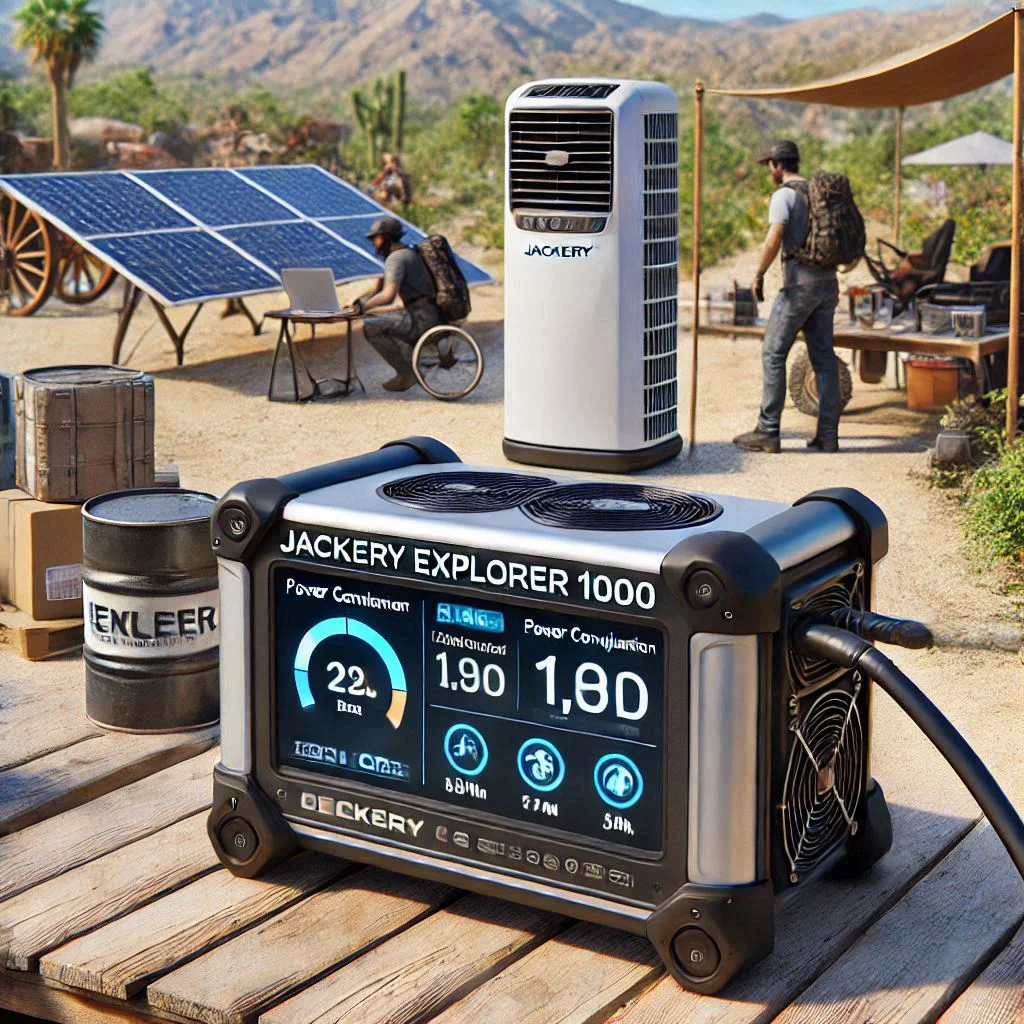
How Long Can a Jackery Solar Generator Power an Air Conditioner?
The duration that a Jackery Solar Generator can power a portable air conditioner depends on several factors:
- AC Unit Size: Larger air conditioners consume more power, reducing the duration they can run.
- Battery Capacity: The Jackery models with higher capacities (Explorer 1500 or 2000) can run air conditioners for longer periods than smaller models like the Explorer 1000.
- Solar Panel Efficiency: The efficiency of your solar panels in charging the generator during the day will also affect how long the generator can power the AC.
On average:
- The Jackery Explorer 1000 can run a small AC unit for 4 to 6 hours.
- The Jackery Explorer 1500 or 2000 can provide cooling for up to 10-12 hours, depending on the AC unit’s energy consumption and sunlight conditions for recharging.

Do I Need to Charge My Jackery Solar Generator Every Time I Use It?
It is ideal to charge your Jackery Solar Generator before each use, especially if you plan on running your air conditioner for extended periods. However, if your generator still has enough charge from the previous use, you can power your air conditioner without needing an immediate recharge.
To maximize efficiency:
- Ensure the generator is fully charged before use.
- If possible, place the solar panels in direct sunlight throughout the day to keep the generator charged, especially if you plan to use the AC in the evening.
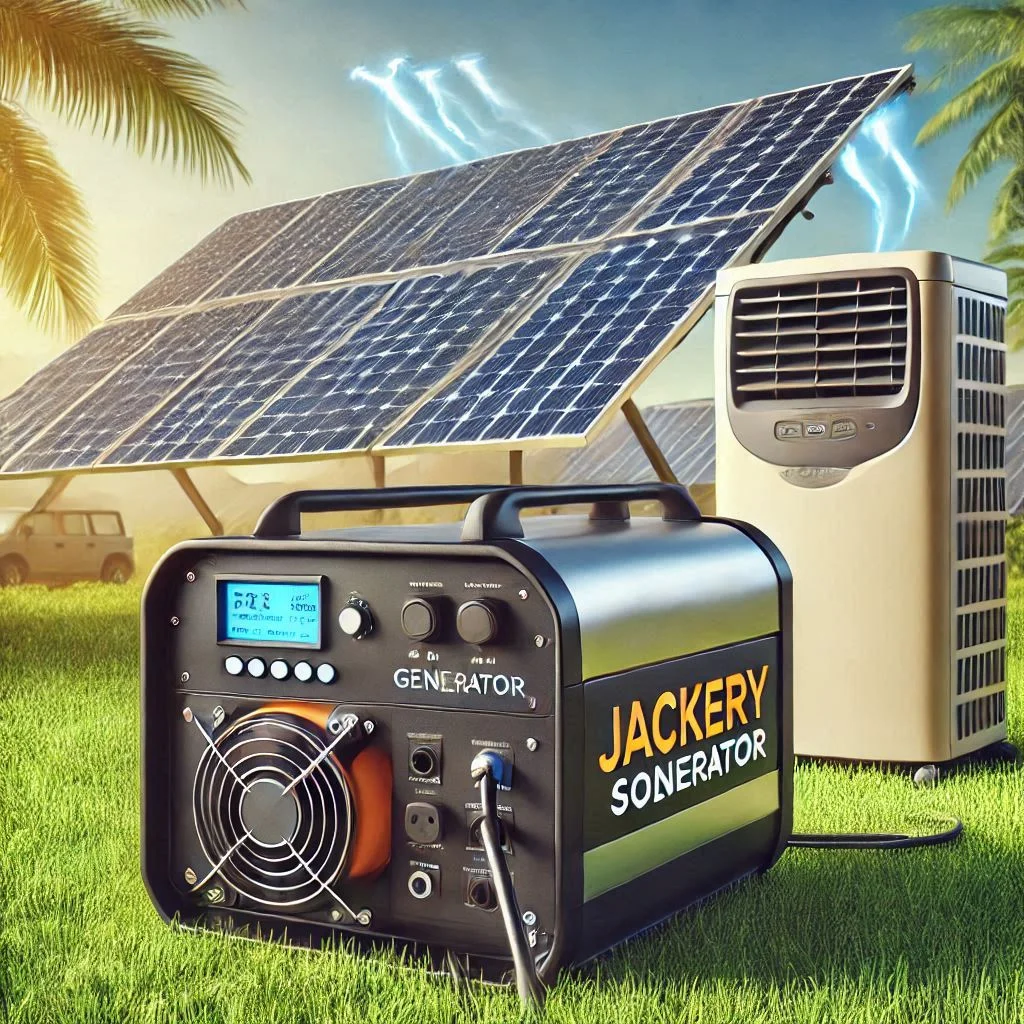
Is Using a Jackery Solar Generator for an Air Conditioner Environmentally Friendly?
Yes, using a Jackery Solar Generator for a portable air conditioner is an environmentally friendly option. Solar energy is renewable and does not emit harmful gases, unlike traditional fossil-fuel-powered electricity generation. By choosing solar power:
- You reduce your carbon footprint.
- You contribute to sustainable energy practices by using clean, renewable resources to power your outdoor cooling solutions.
- You can enjoy cooling without worrying about the environmental impact of your energy consumption.
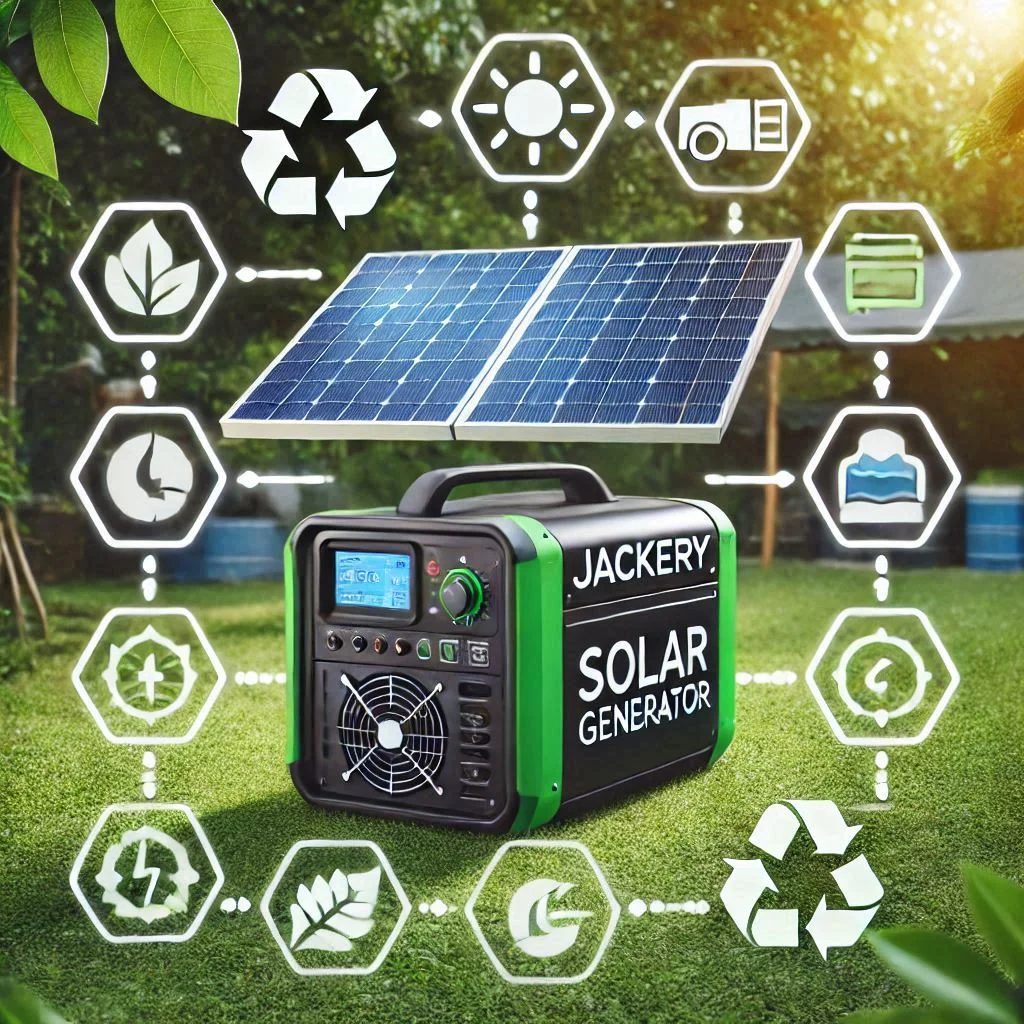
How Do I Maintain My Jackery Solar Generator for Optimal Performance?
Maintaining your Jackery Solar Generator is crucial for ensuring it continues to function optimally, especially when powering a portable air conditioner. Here are some key tips for maintaining your solar generator:
- Regularly Clean the Solar Panels: Dust and debris can reduce the efficiency of solar panels. Clean them with a soft cloth or brush every few weeks, especially if they are used in outdoor environments.
- Store the Generator Properly: When not in use, store the generator in a cool, dry place. Avoid exposing it to extreme temperatures, which can reduce the battery lifespan.
- Monitor Battery Health: Check the battery levels regularly and avoid letting them drop to zero. Recharge your generator when the battery level reaches 20% to maintain its health.

Can I Use My Jackery Solar Generator for Other Outdoor Devices?
Yes, a Jackery Solar Generator can power multiple devices in addition to your portable air conditioner. These generators come with various output ports, allowing you to power:
- Lighting: Perfect for outdoor parties or gatherings.
- Small Appliances: Such as mini-fridges, fans, or blenders.
- Electronics: Charging phones, tablets, and laptops.
With a high capacity, the Jackery Solar Generator is versatile enough to power multiple devices simultaneously, making it ideal for outdoor events, camping trips, or even off-grid living.
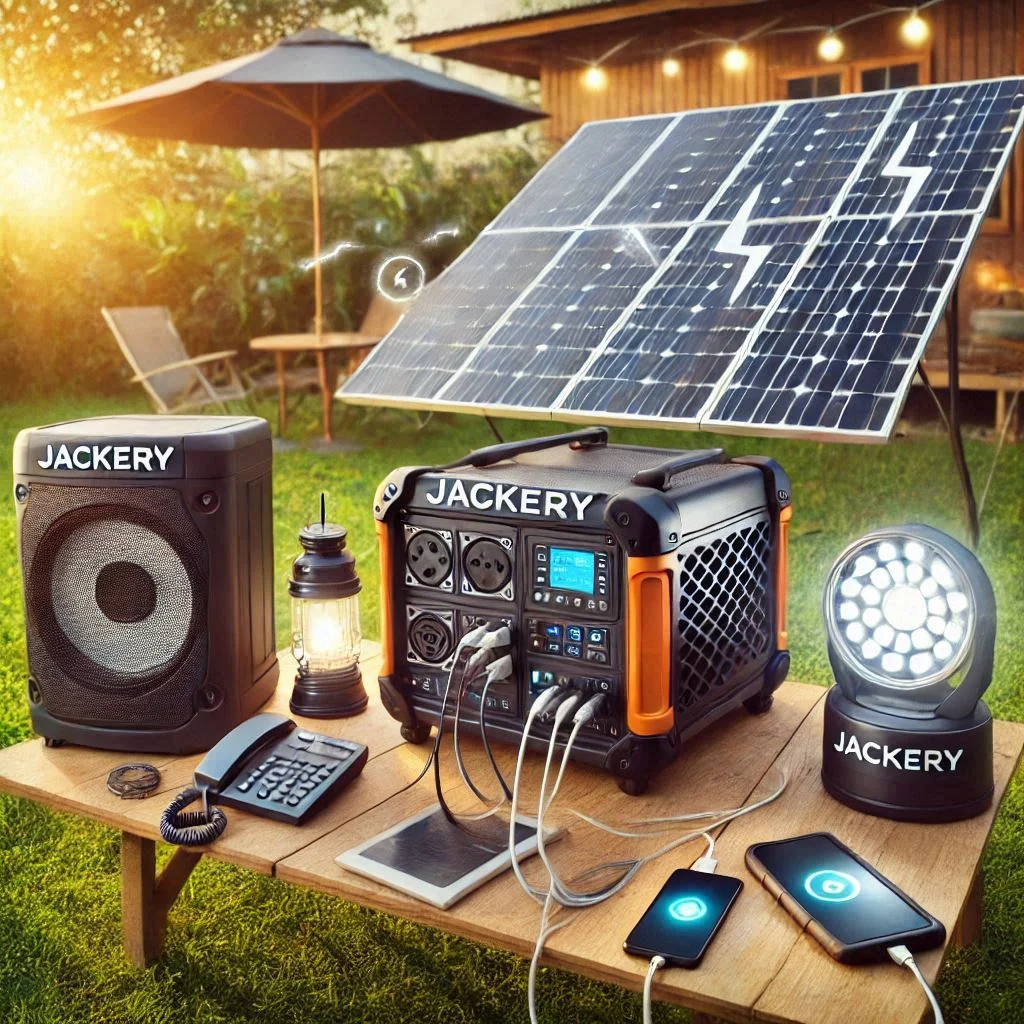
Conclusion:
In conclusion, pairing a Jackery Solar Generator with a portable air conditioner offers a sustainable, off-grid solution for cooling outdoor spaces like patios, decks, and gardens. With advancements in solar technology, these generators provide an environmentally friendly and cost-effective way to keep your outdoor areas cool, even in the heat of summer. By carefully considering factors like BTU, capacity, and solar panel efficiency, you can enjoy a comfortable, eco-conscious outdoor experience without relying on traditional power sources. Whether you’re hosting gatherings or simply relaxing outdoors, a solar-powered air conditioning system ensures that you can stay cool and comfortable while reducing your carbon footprint. With proper maintenance and thoughtful selection of equipment, your Jackery Solar Generator and portable air conditioner setup will offer reliable performance for many seasons to come.

